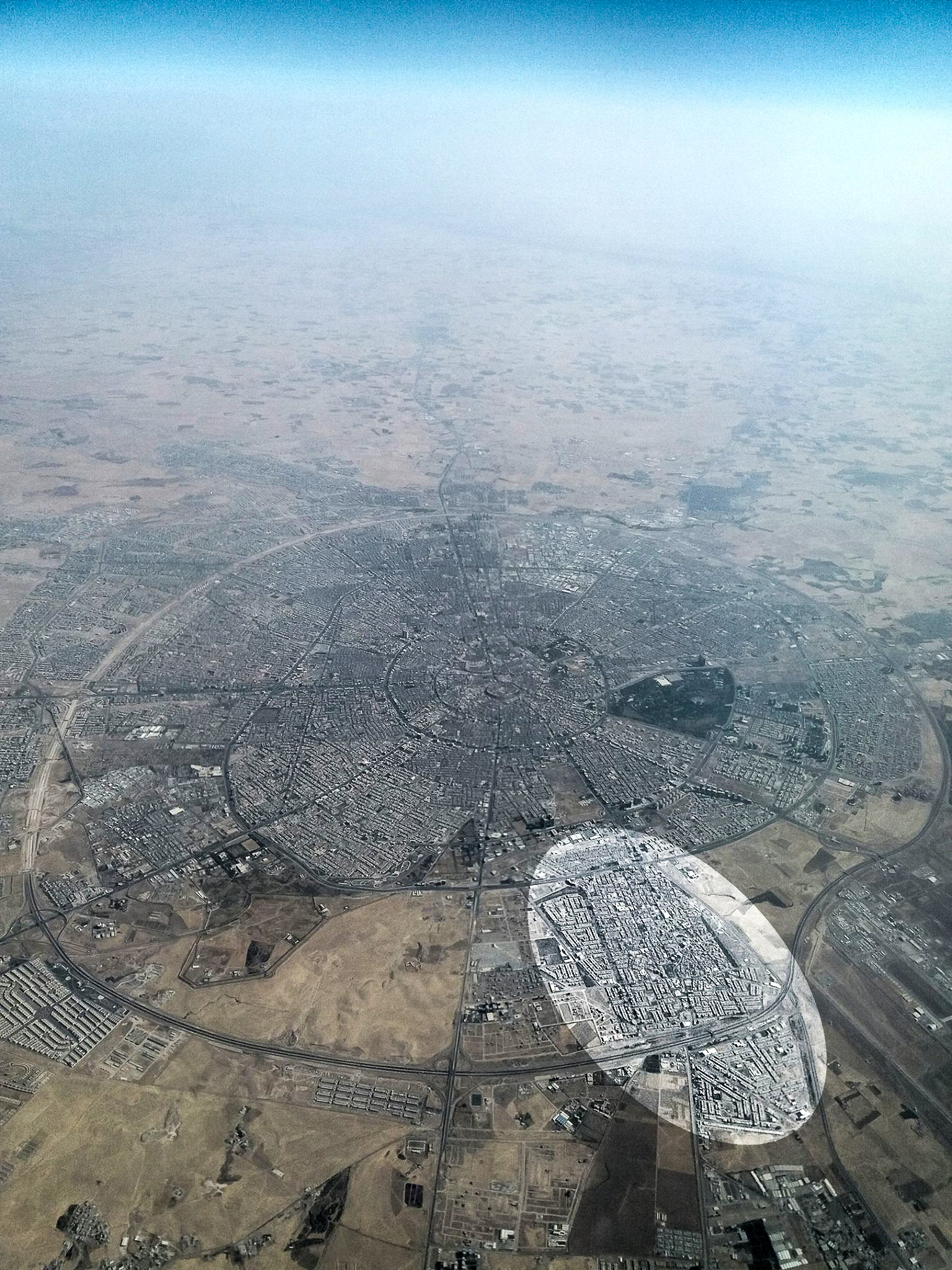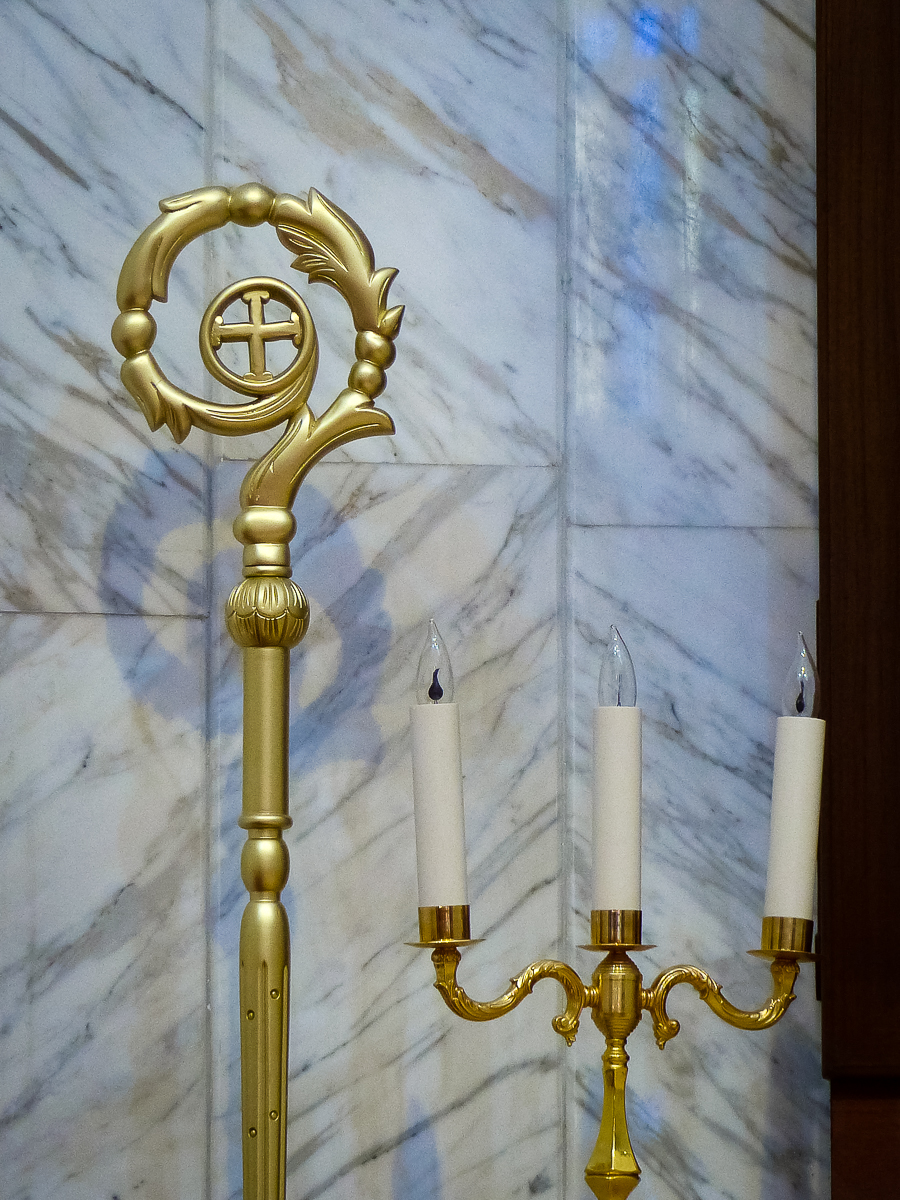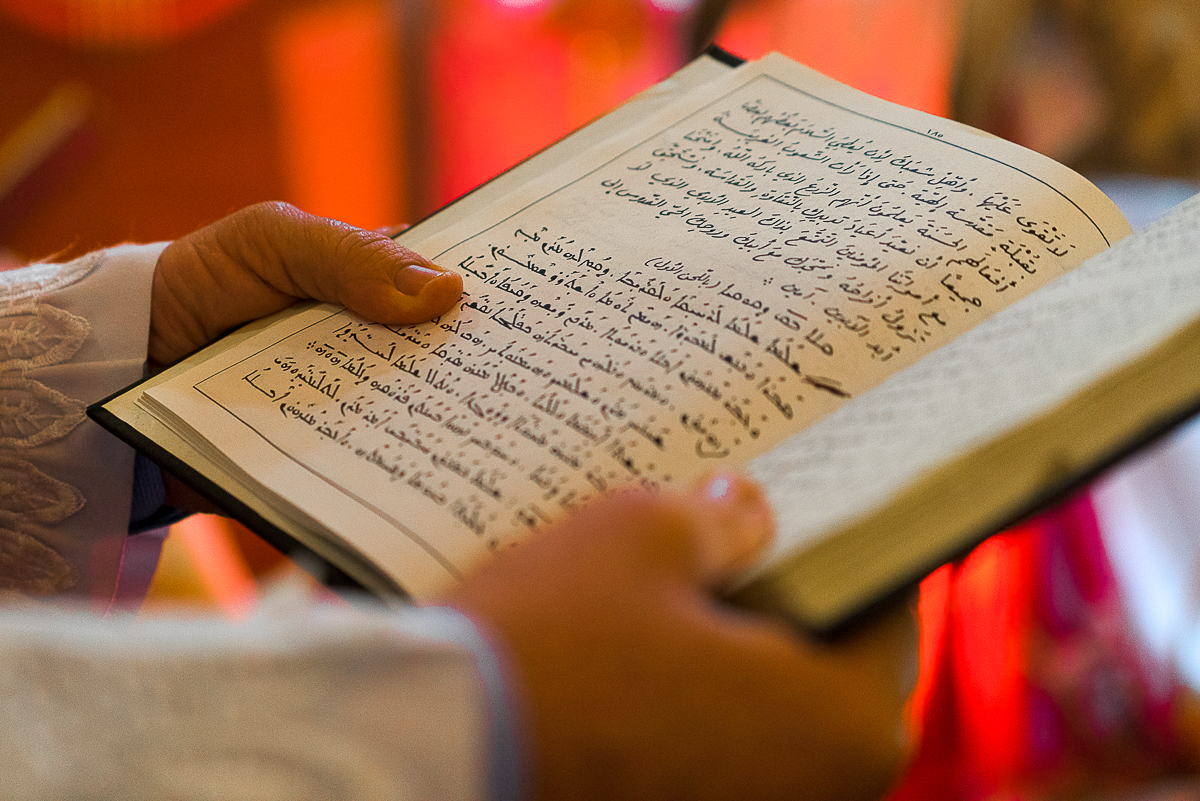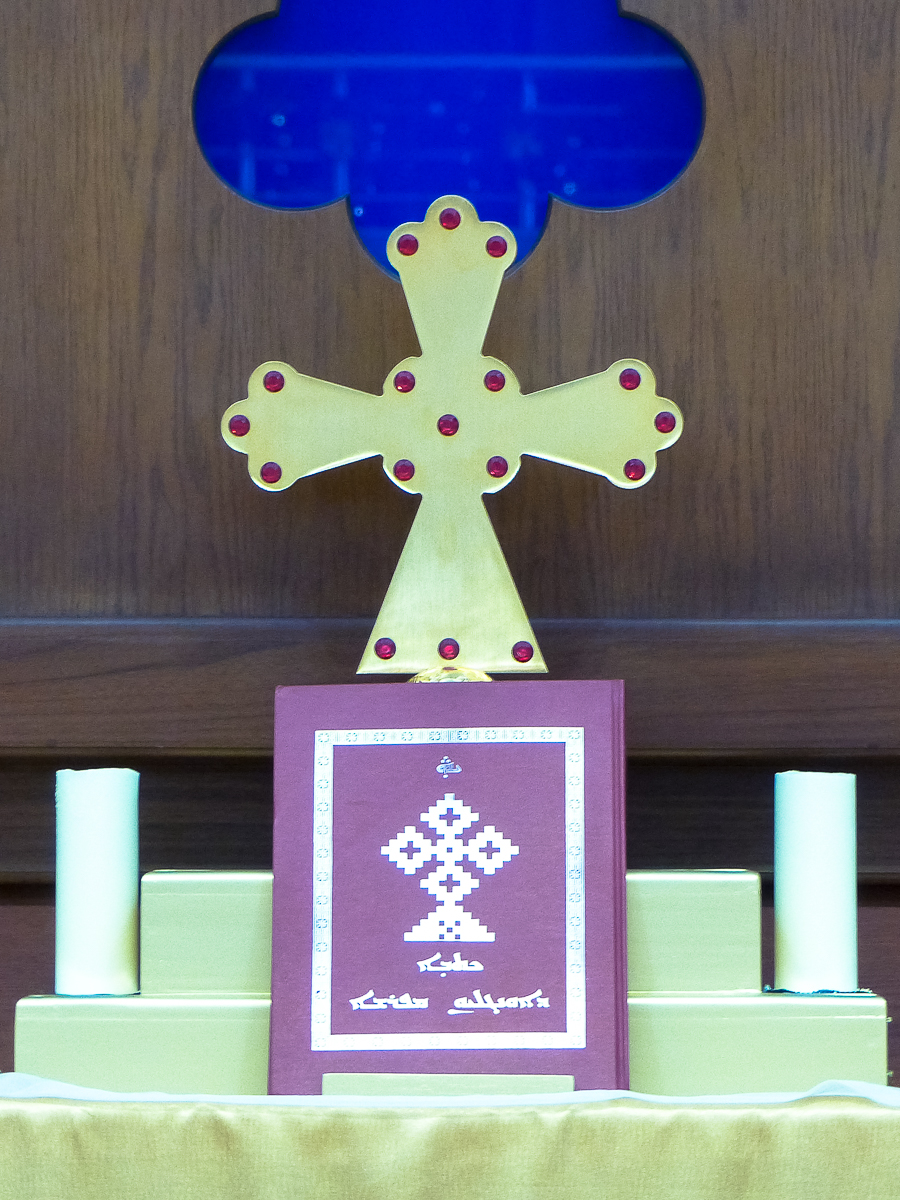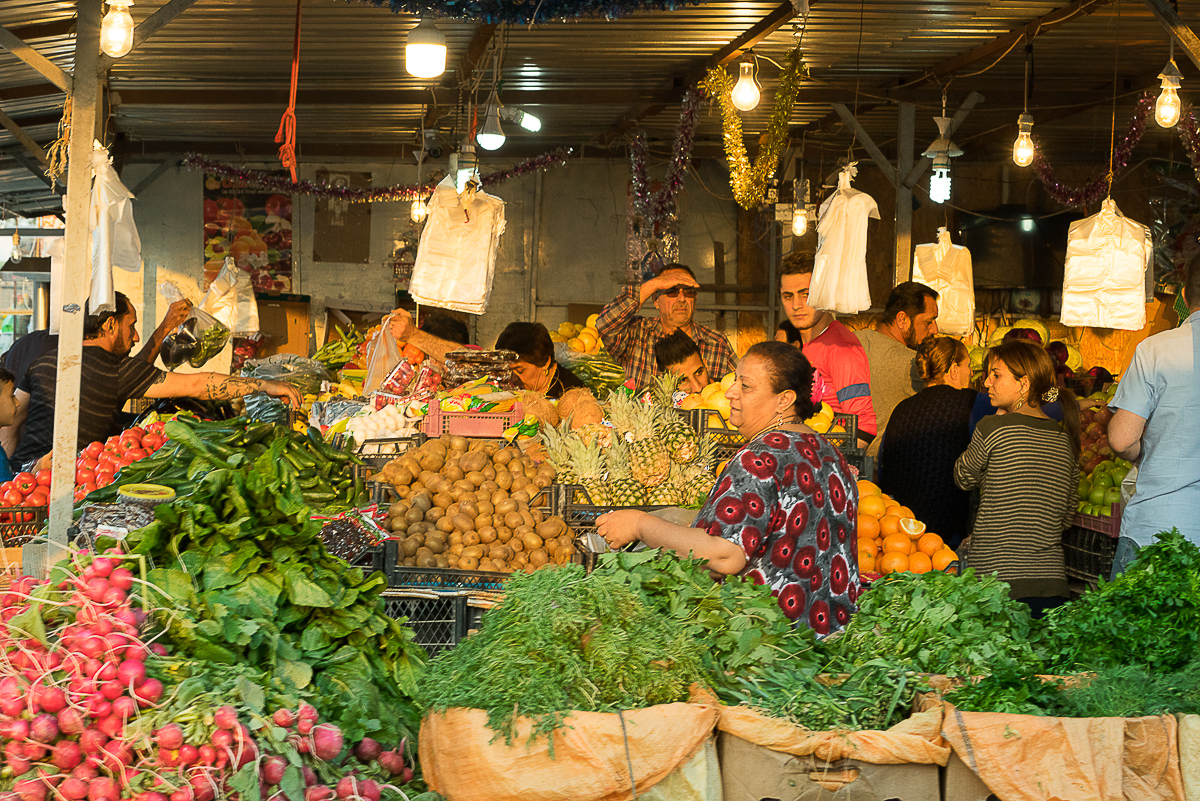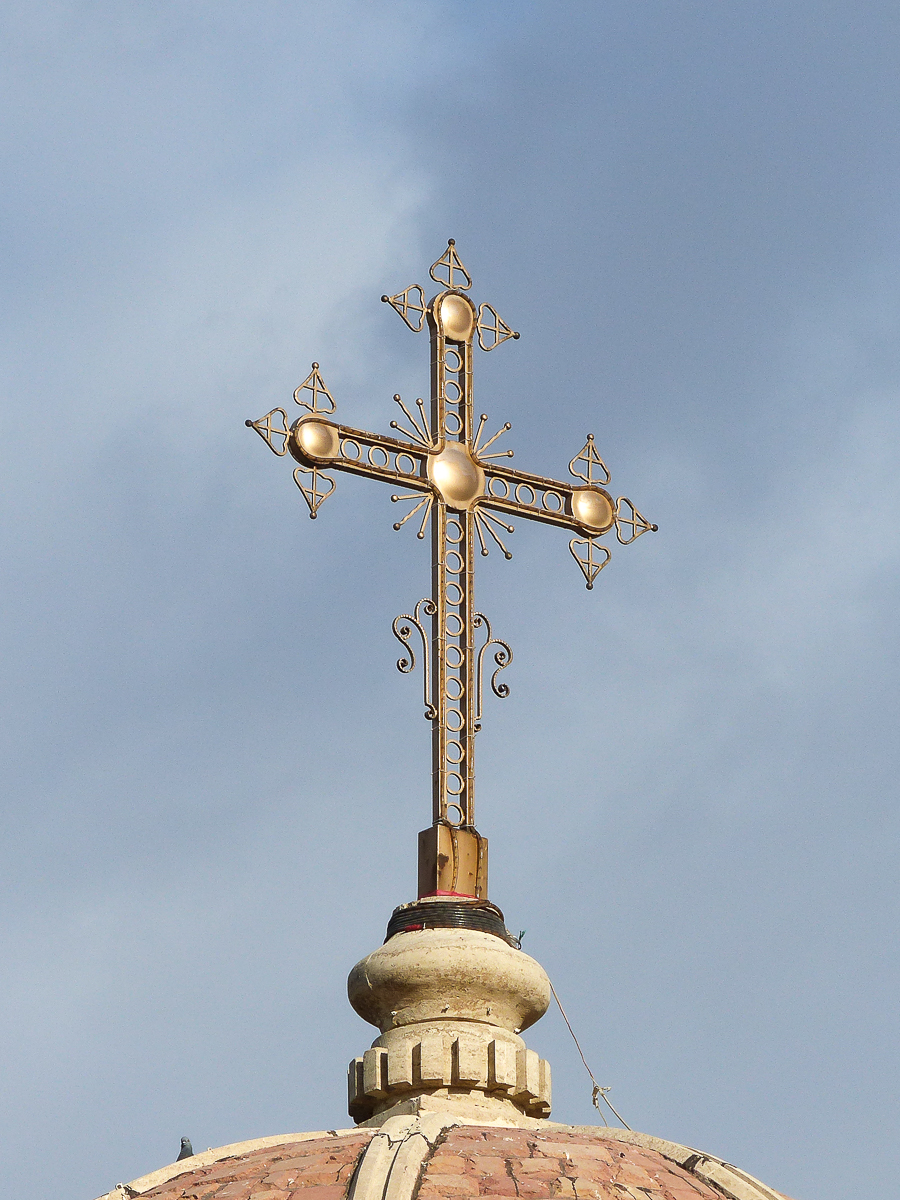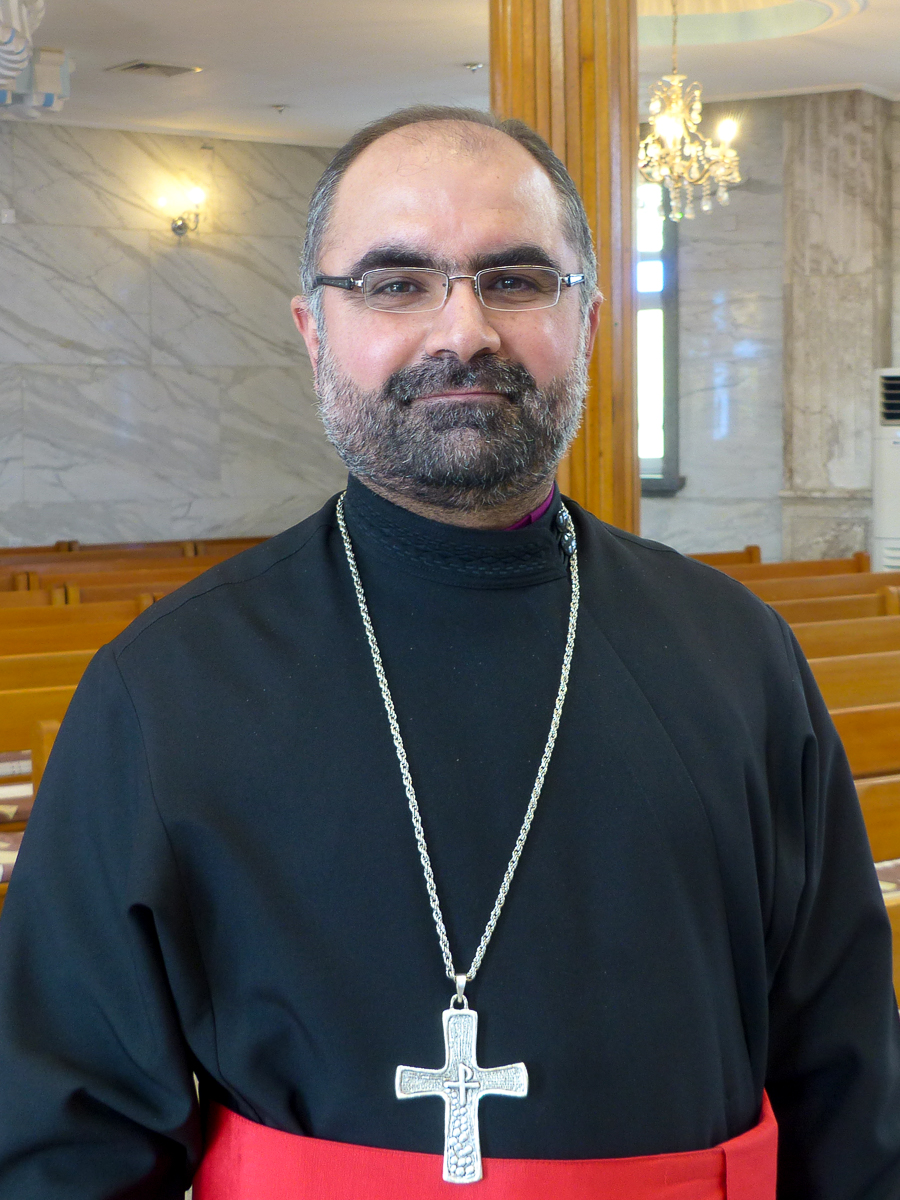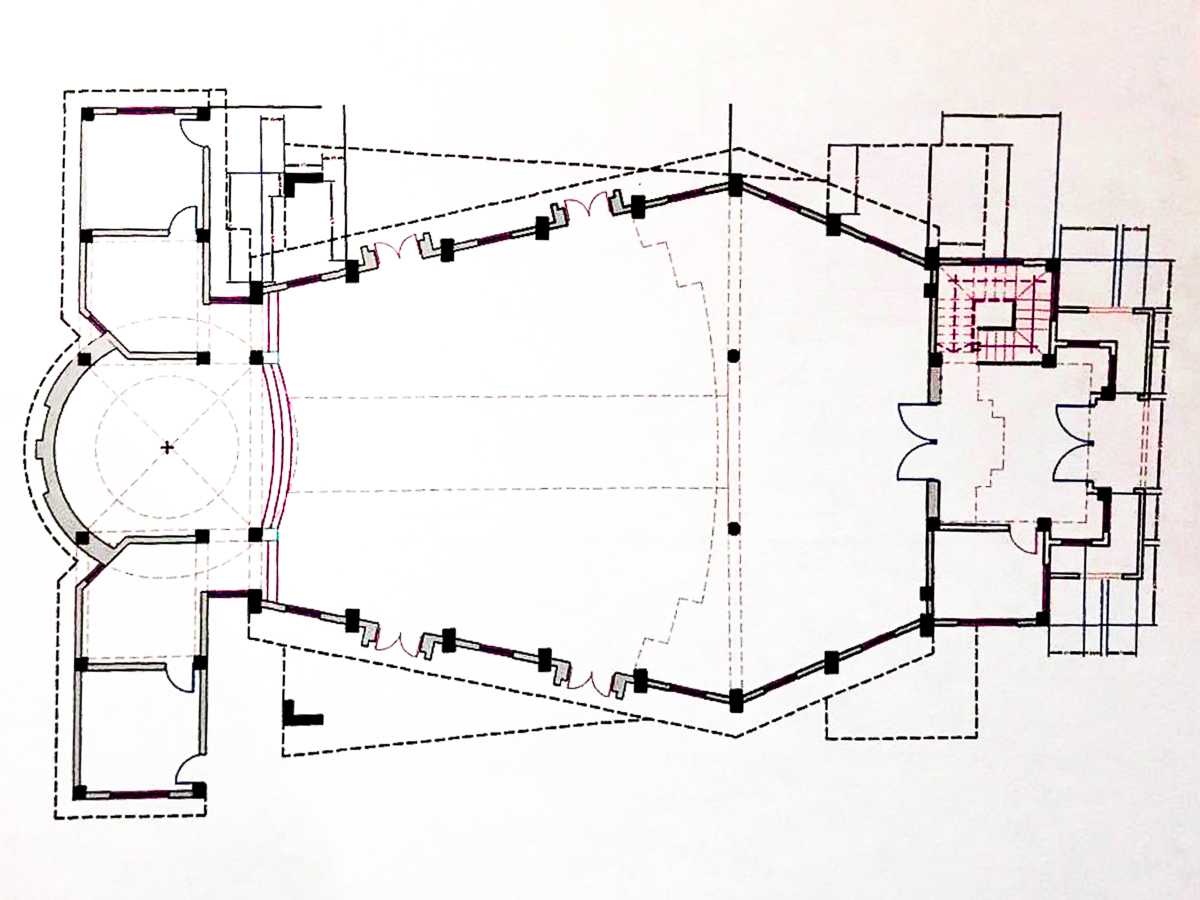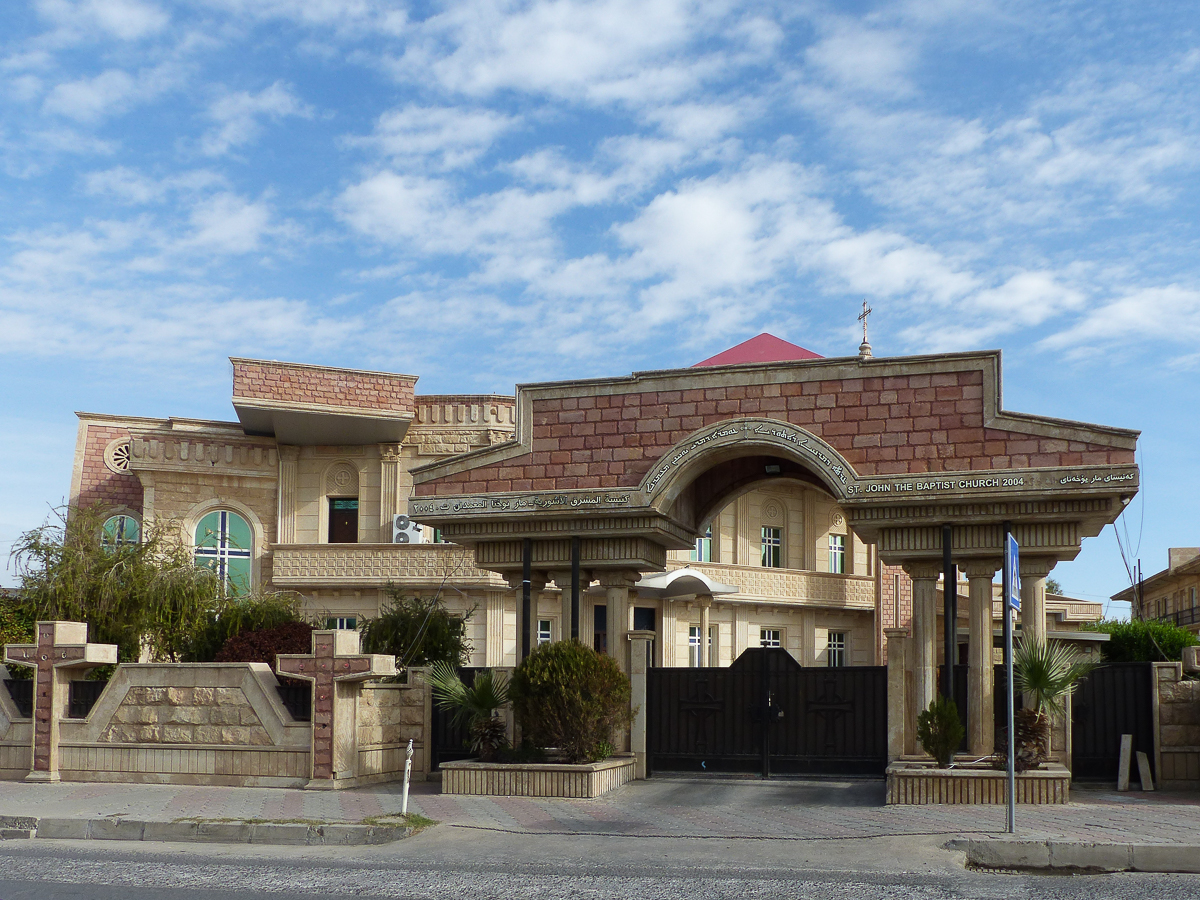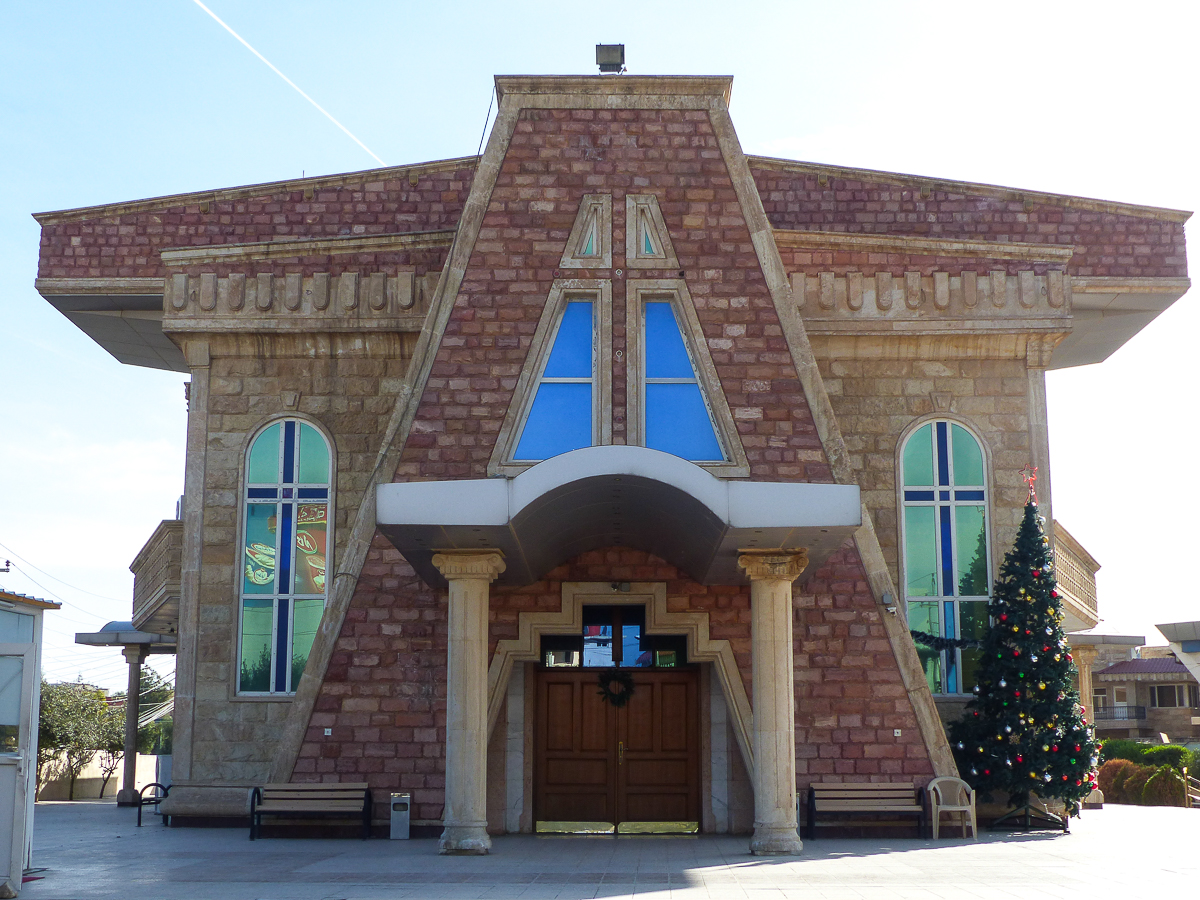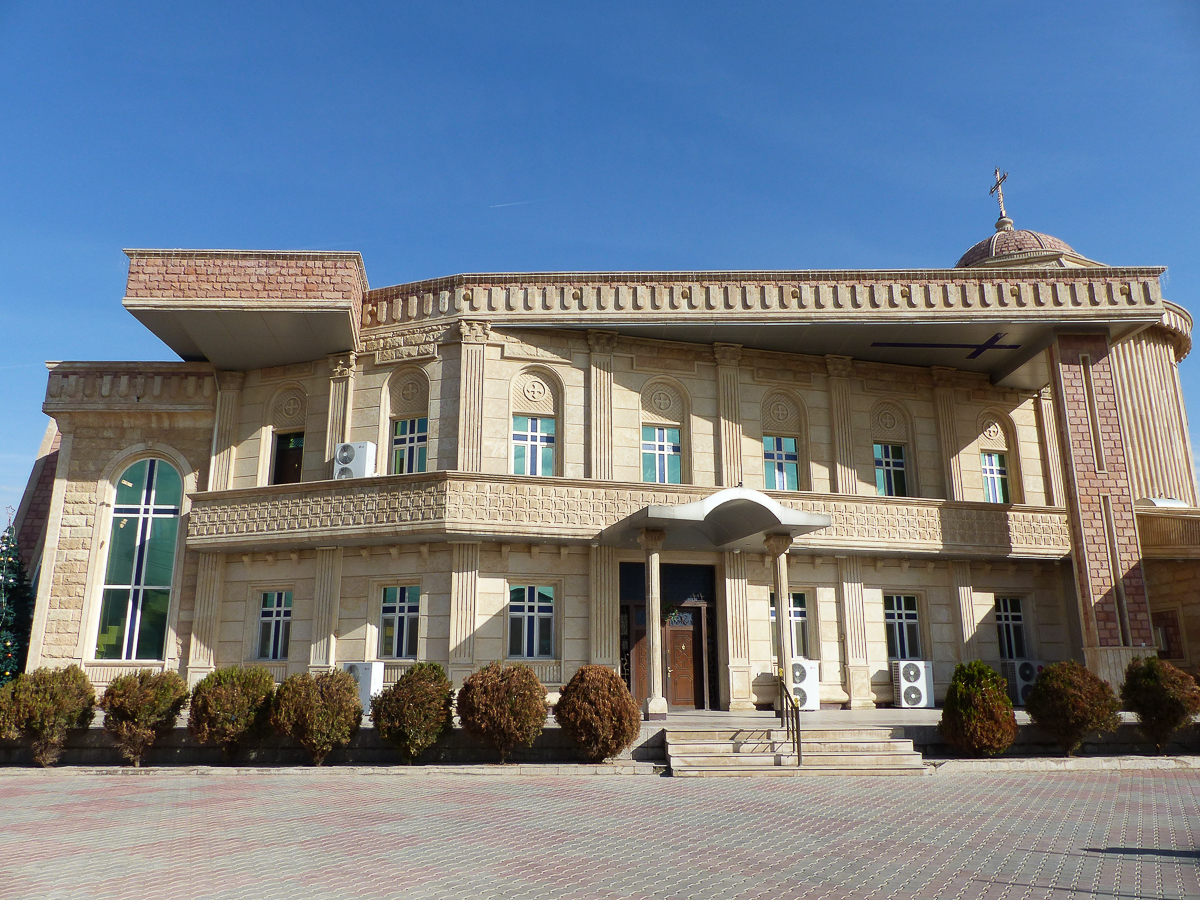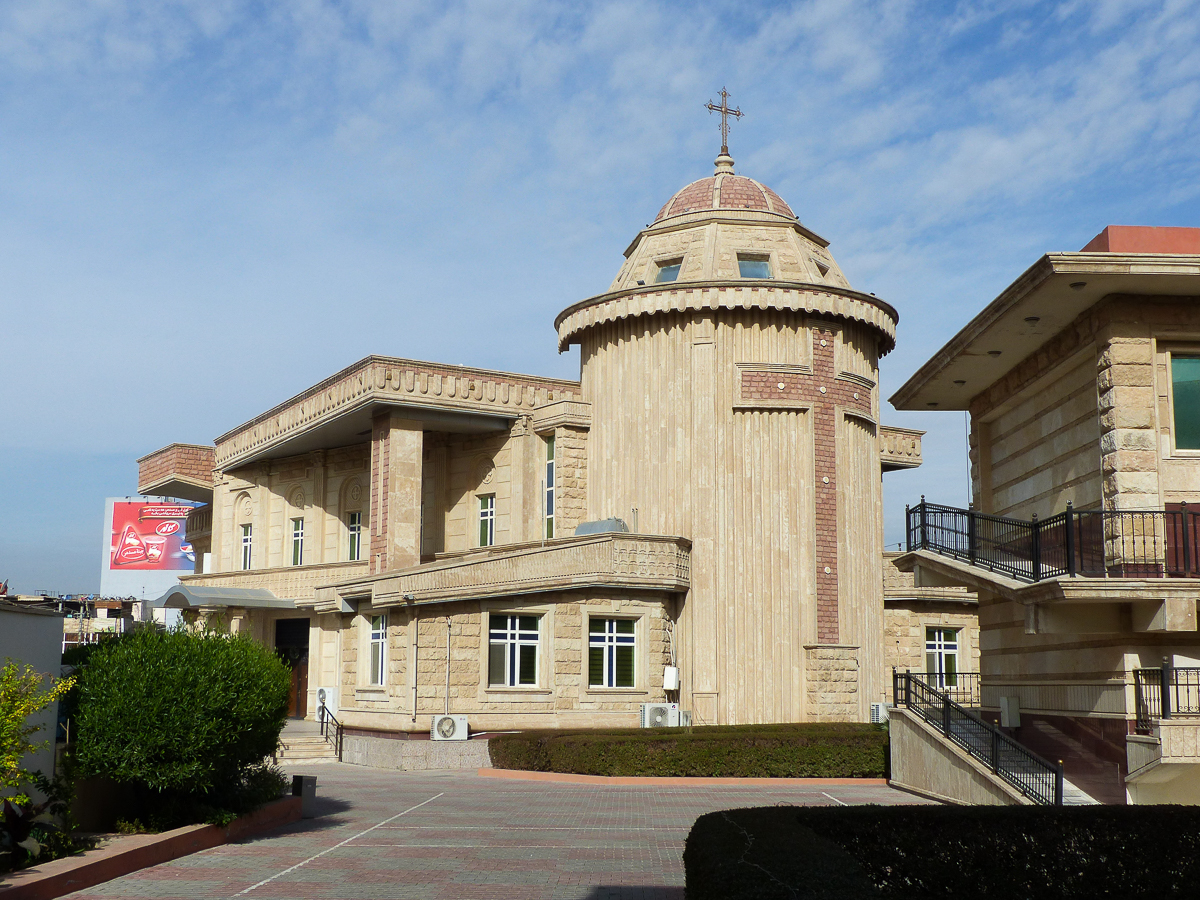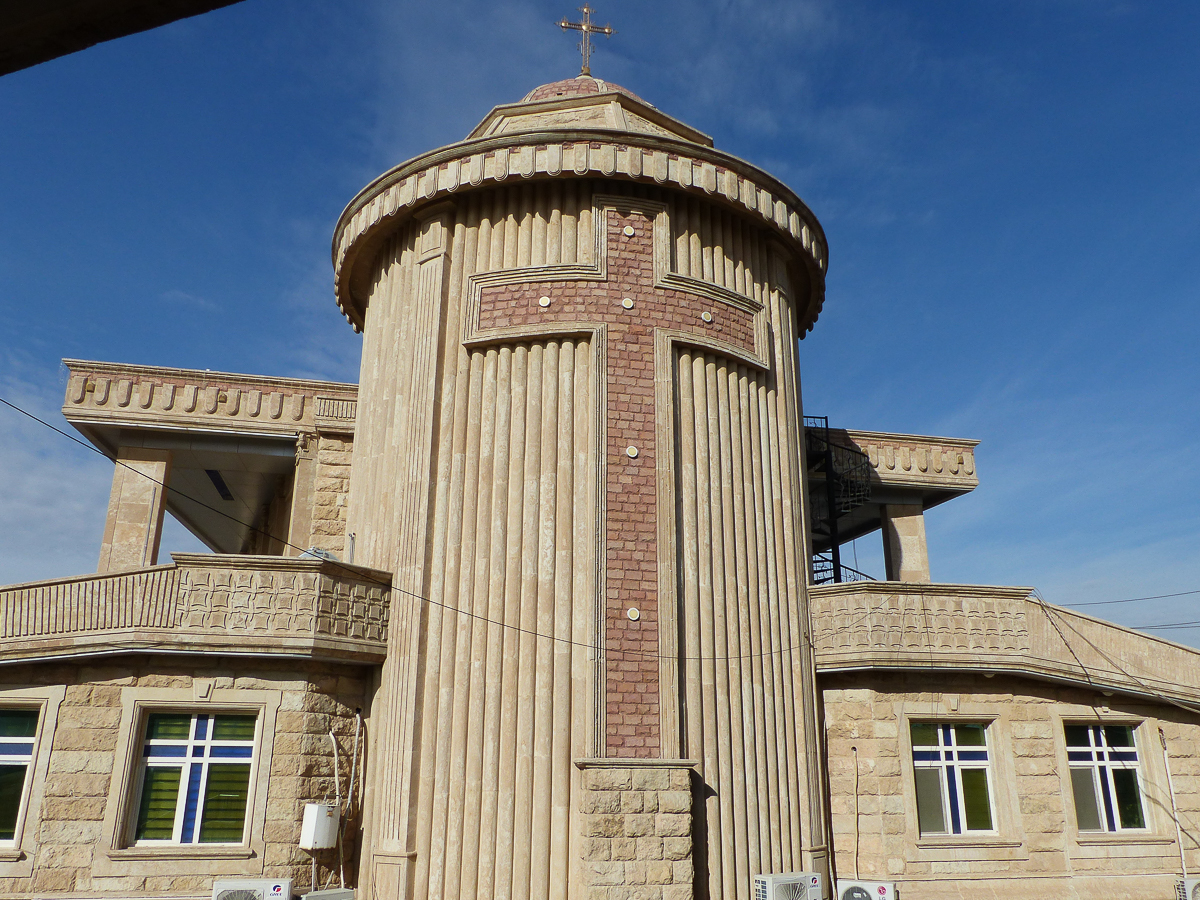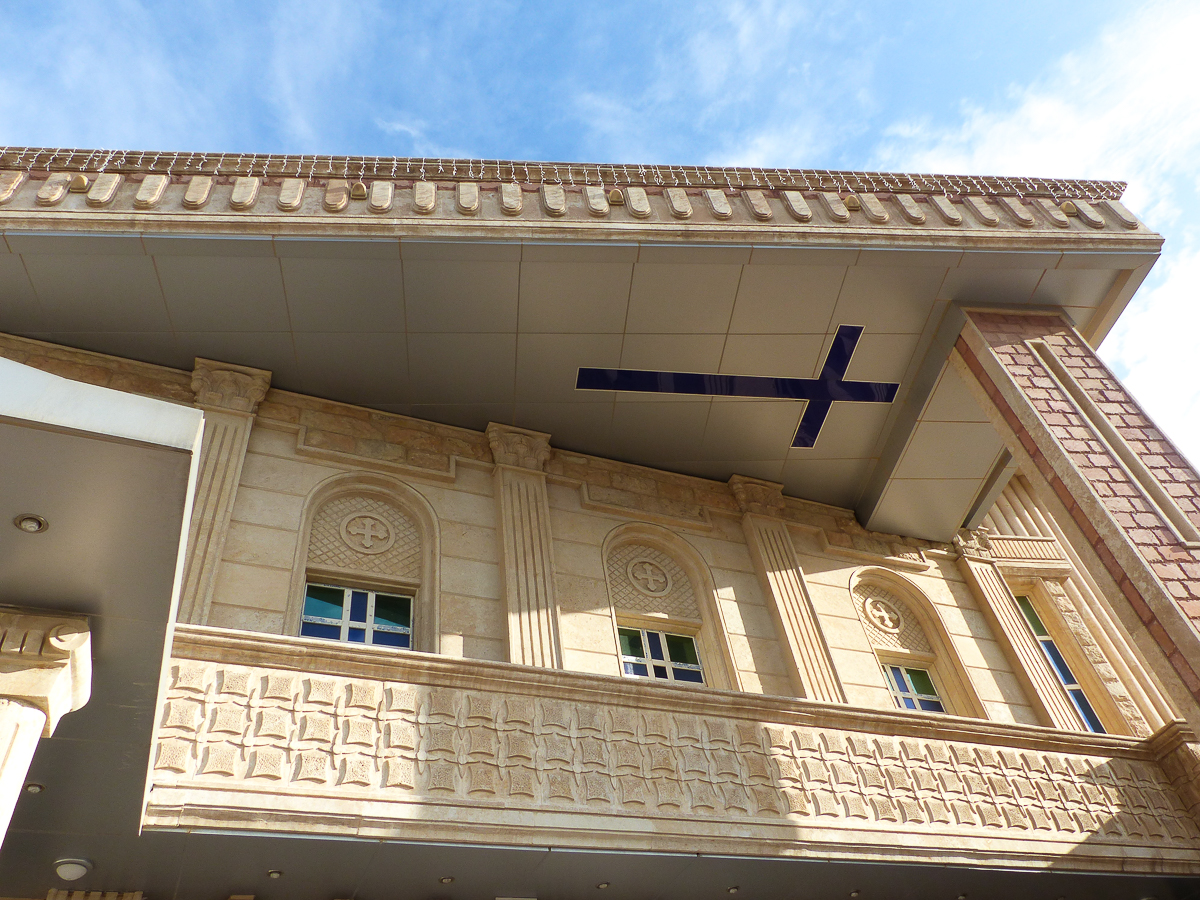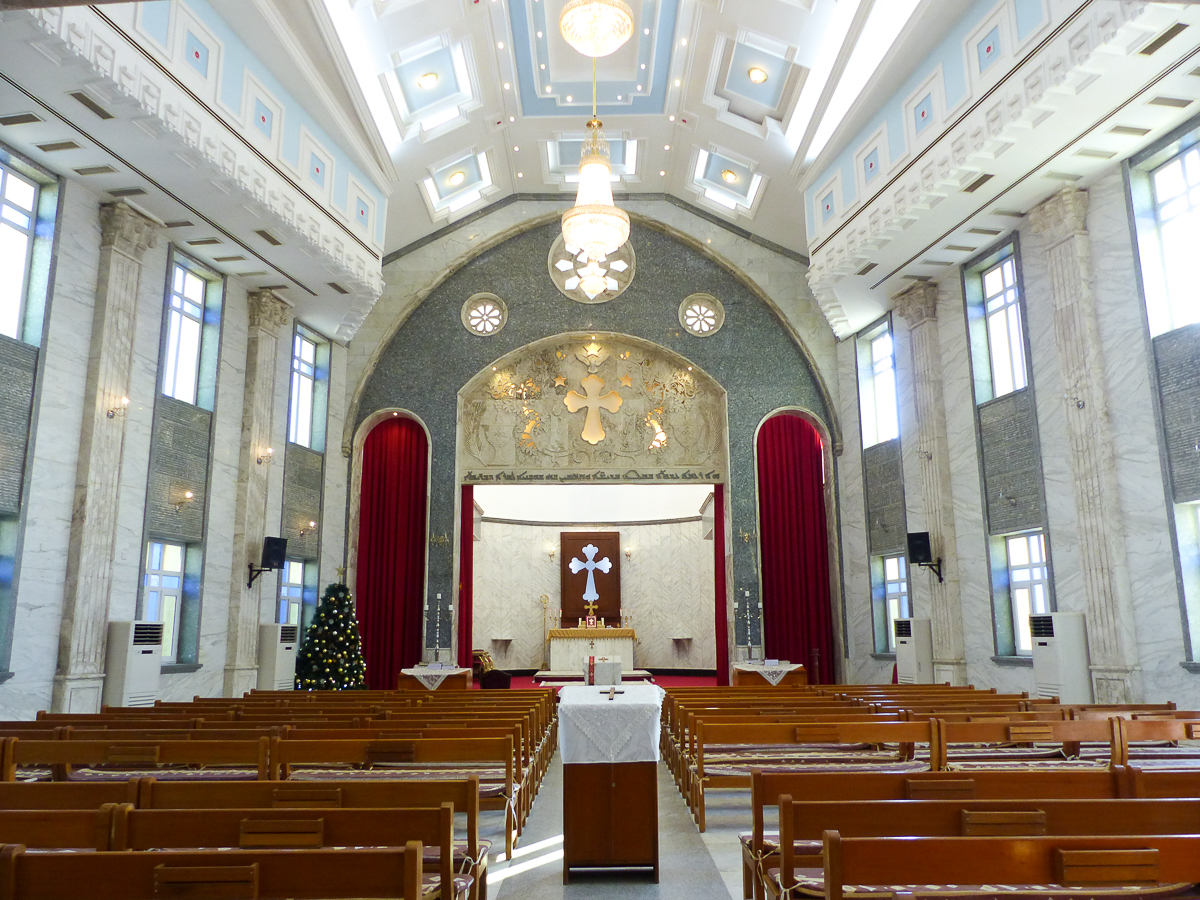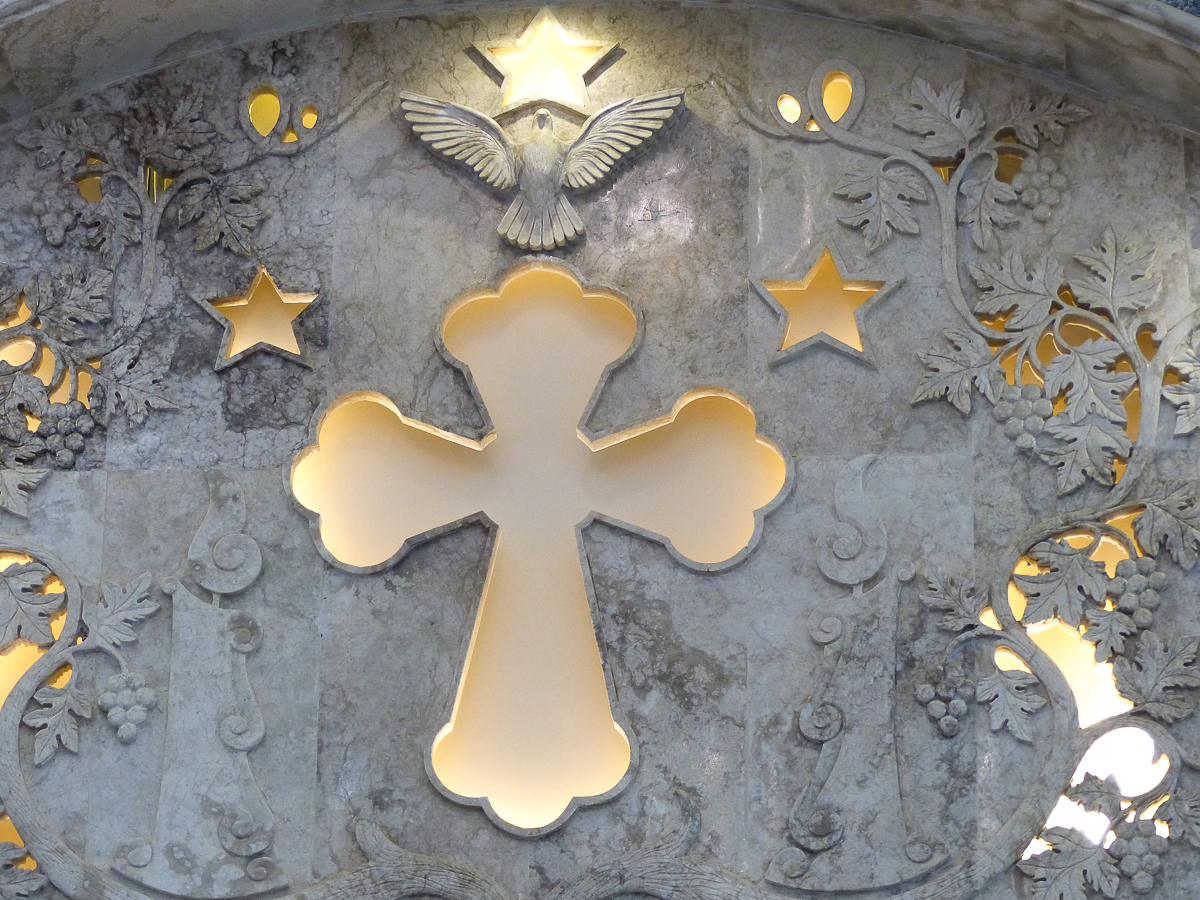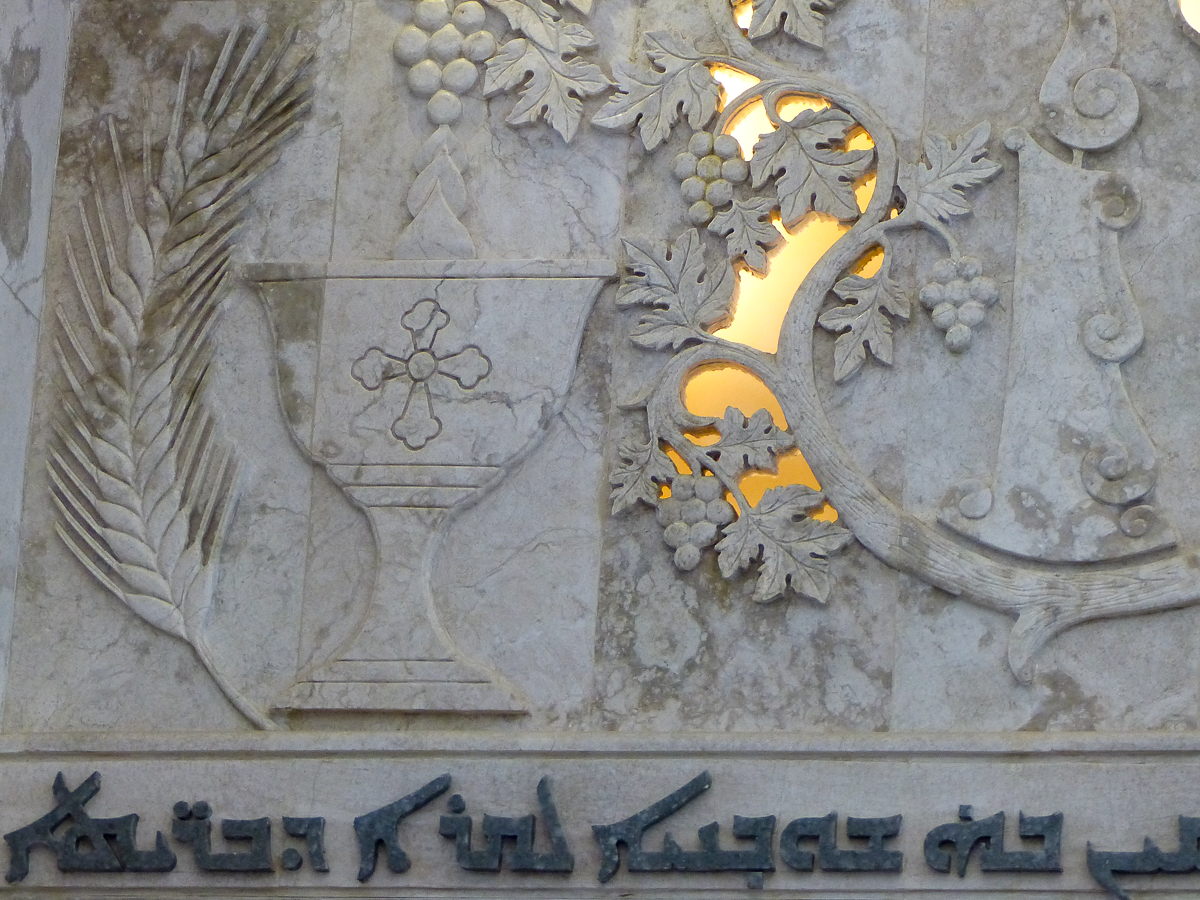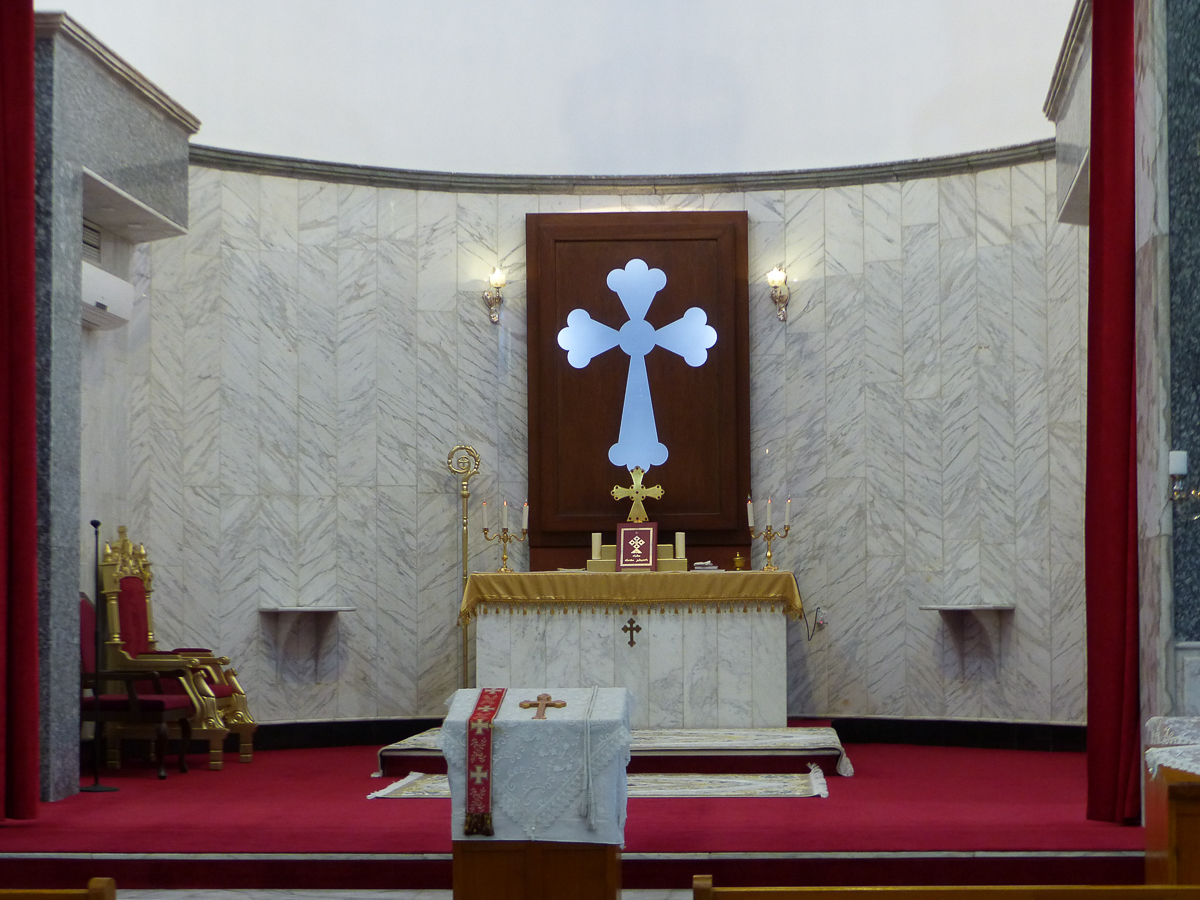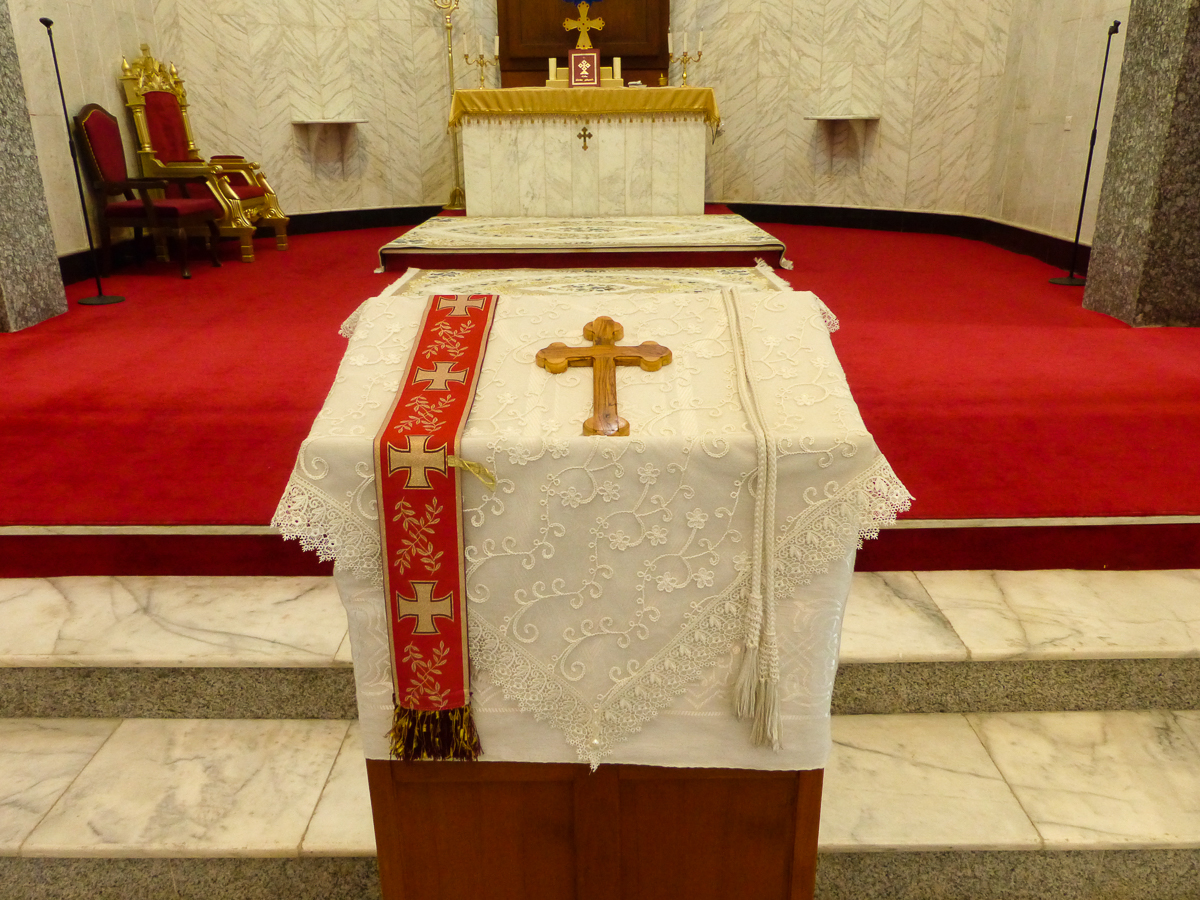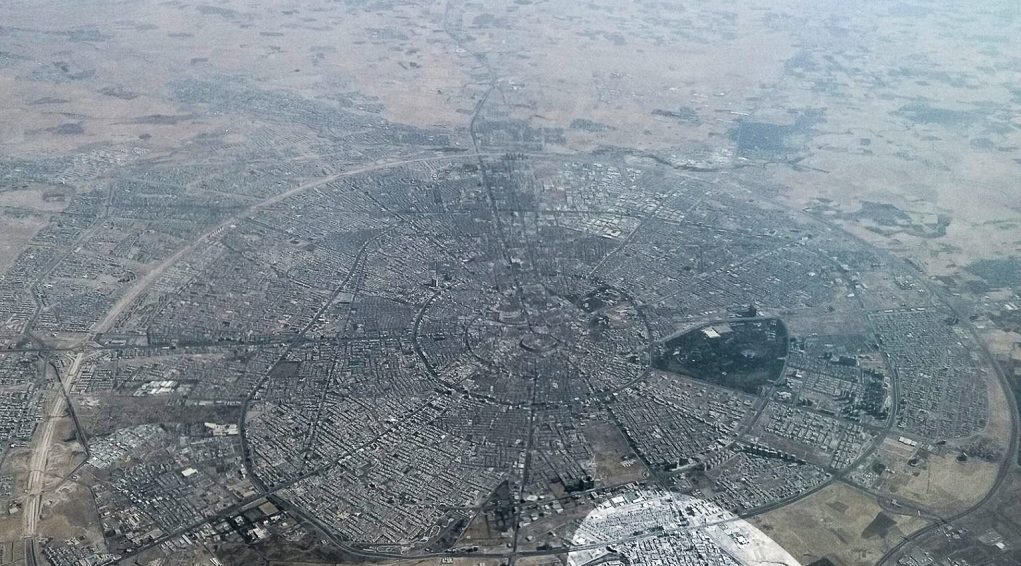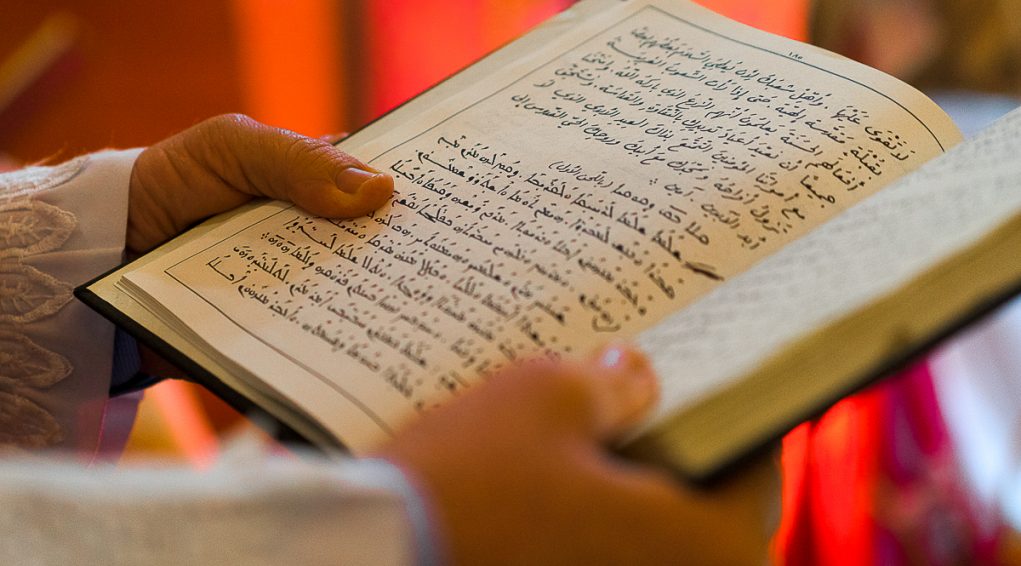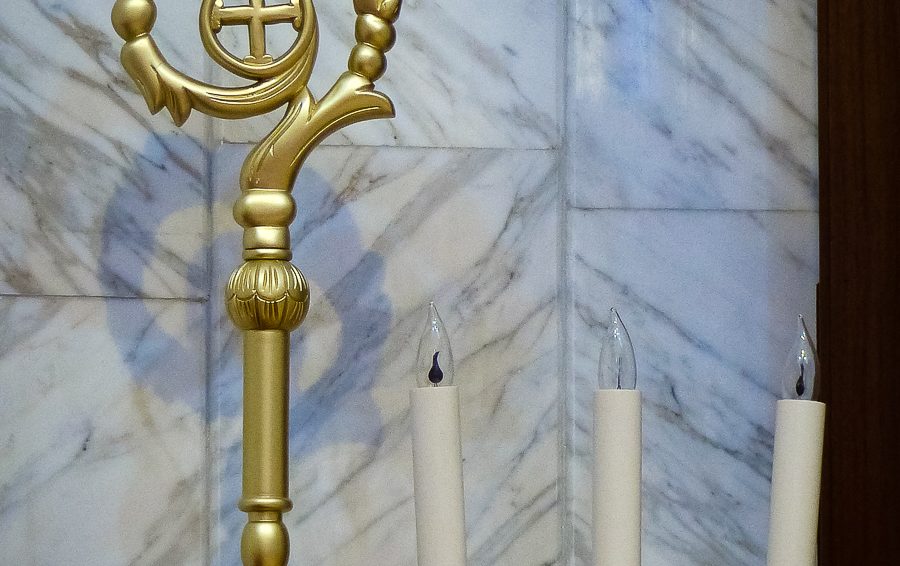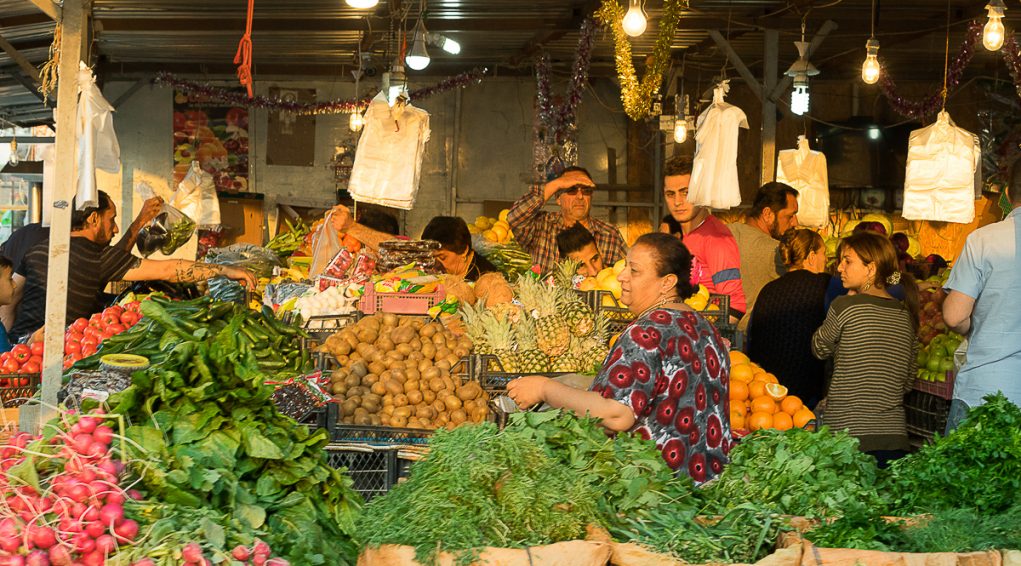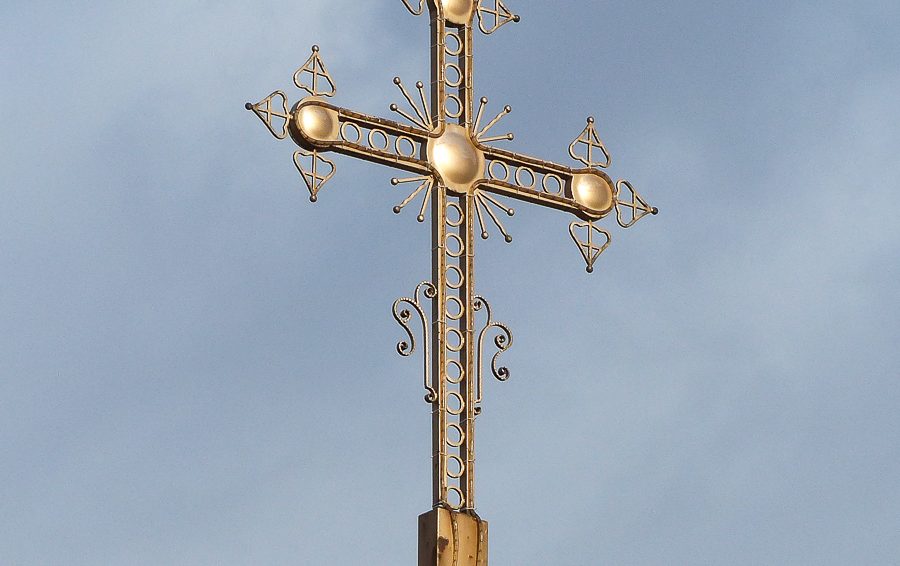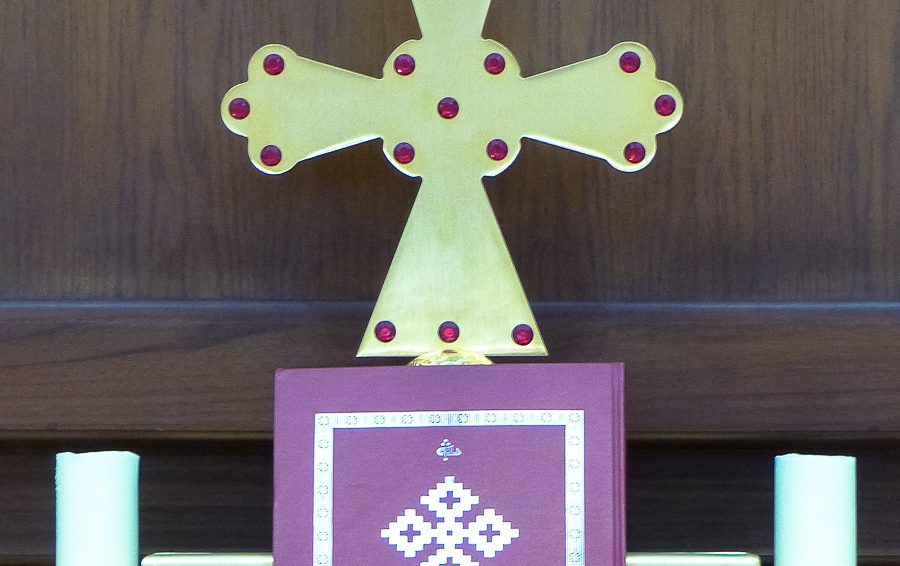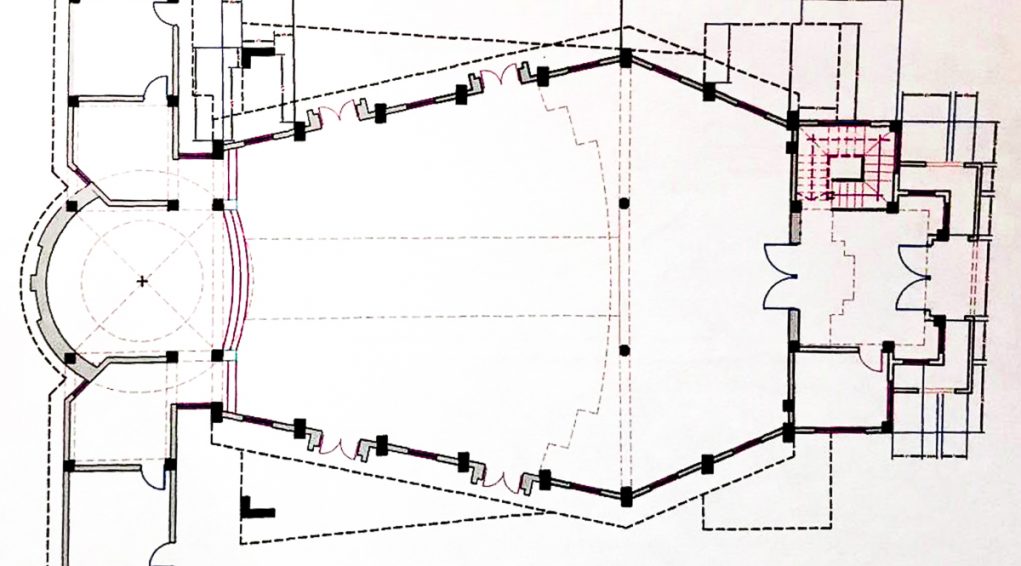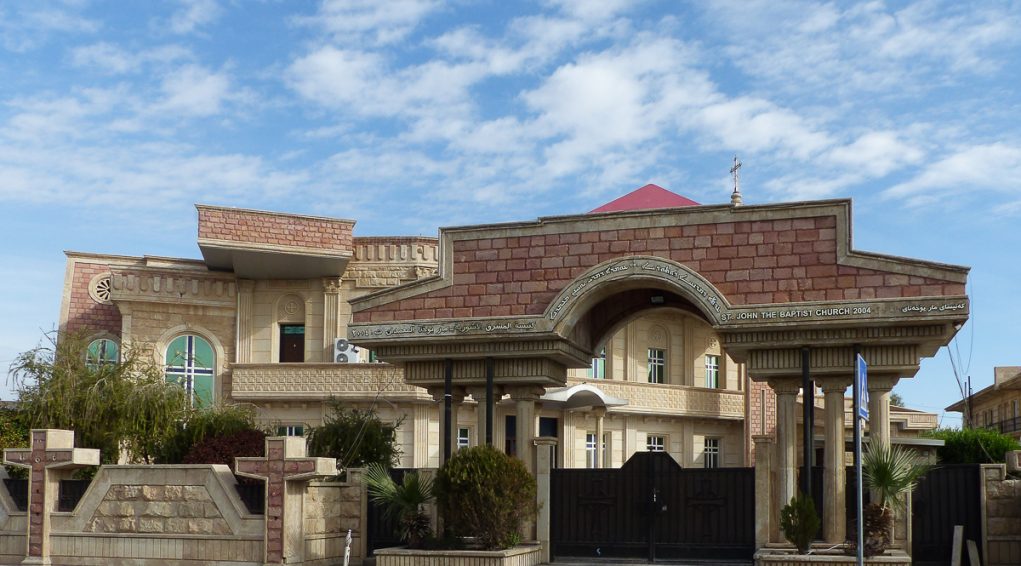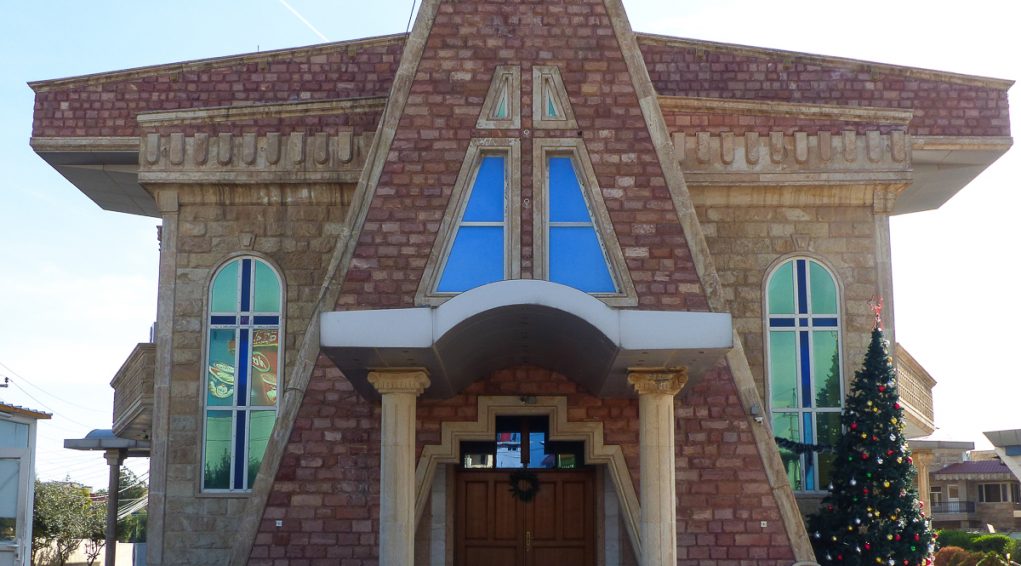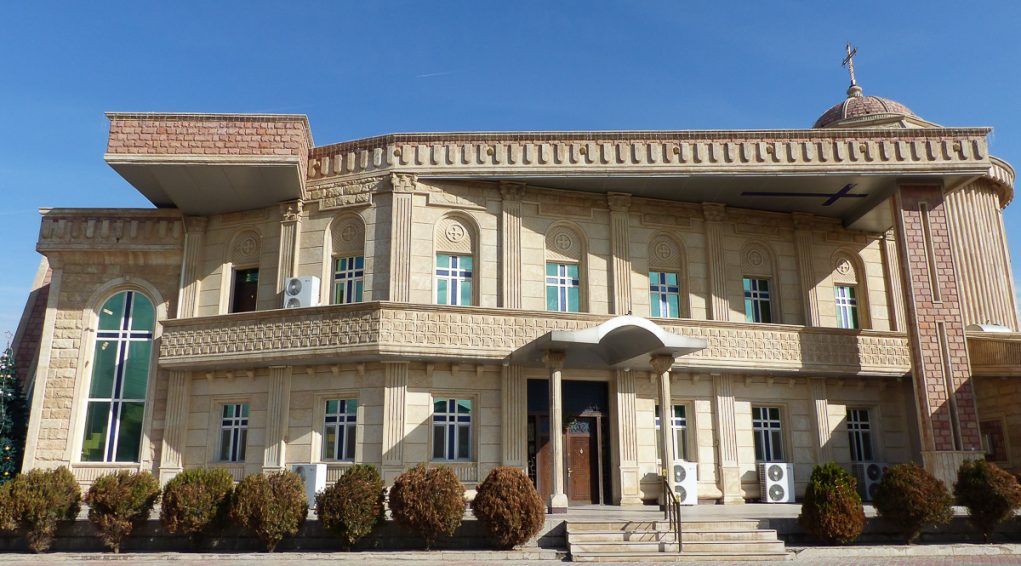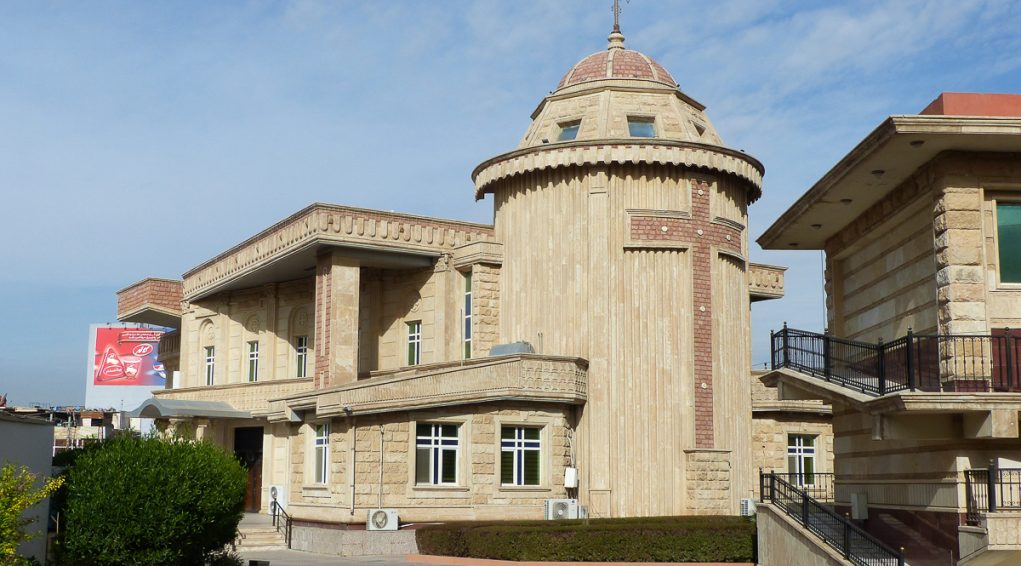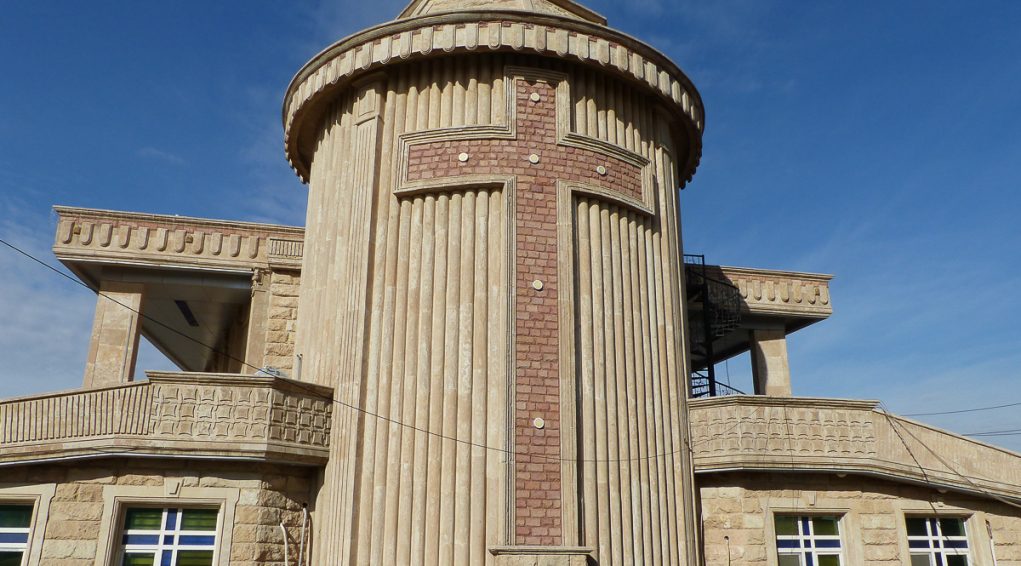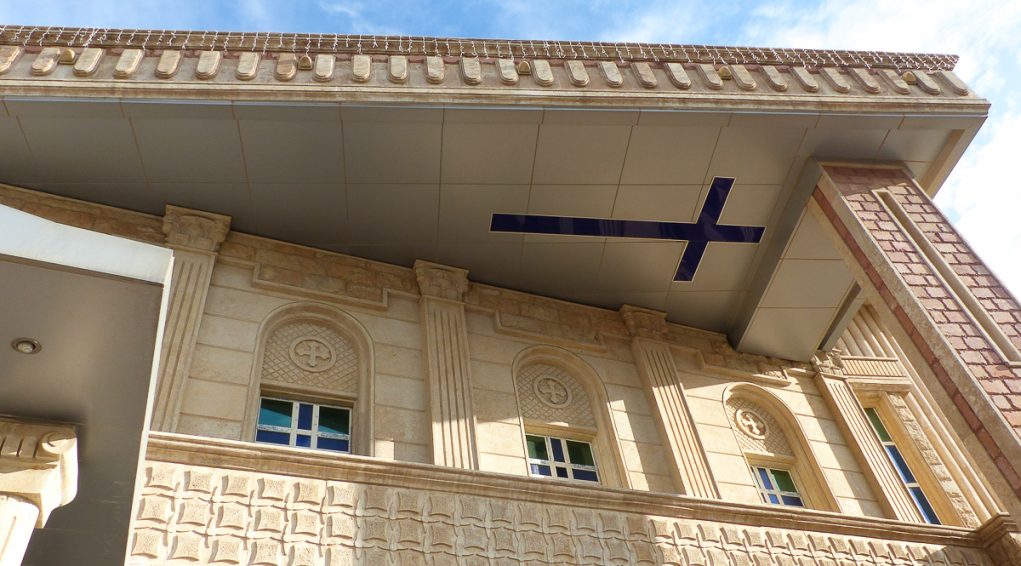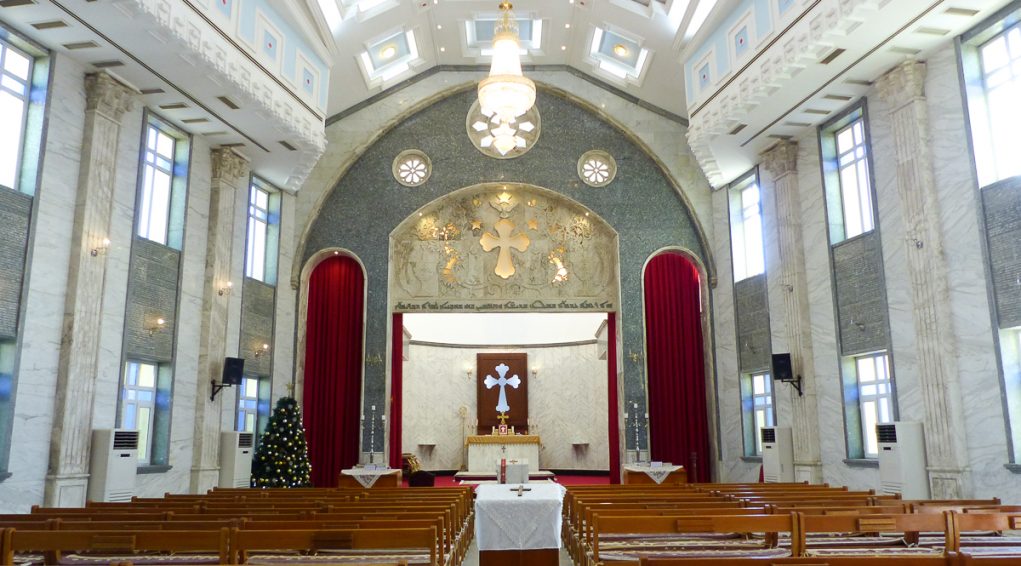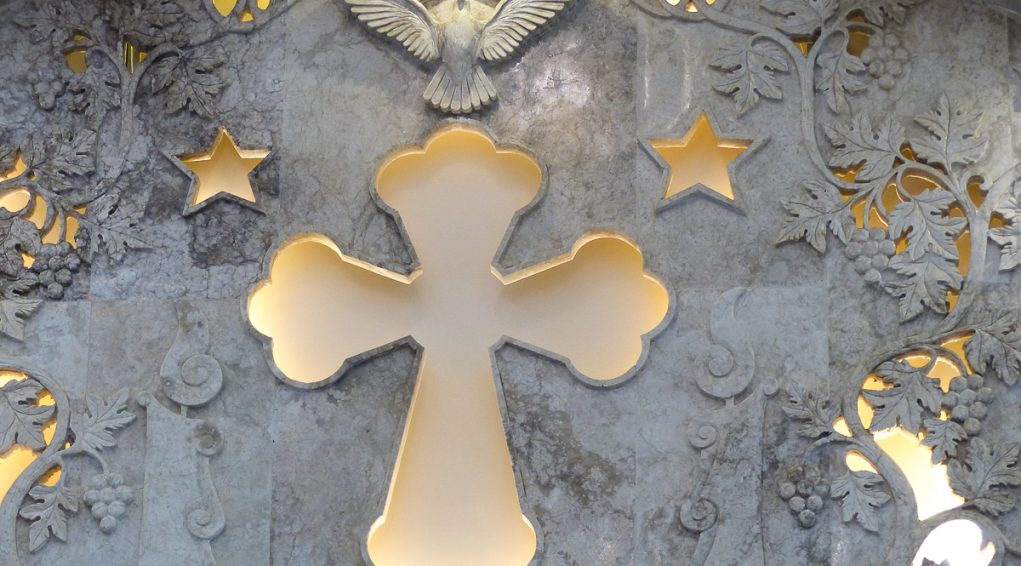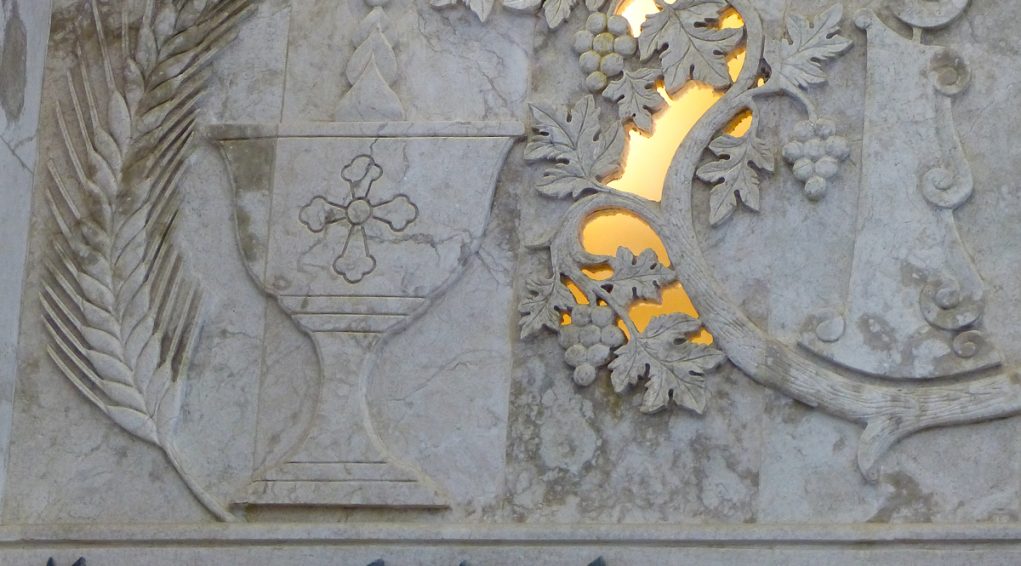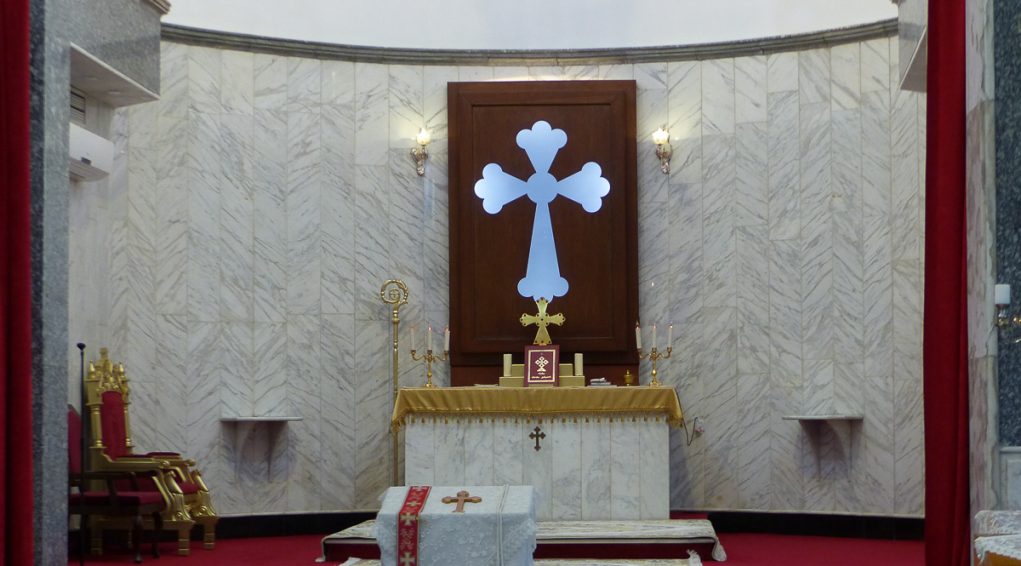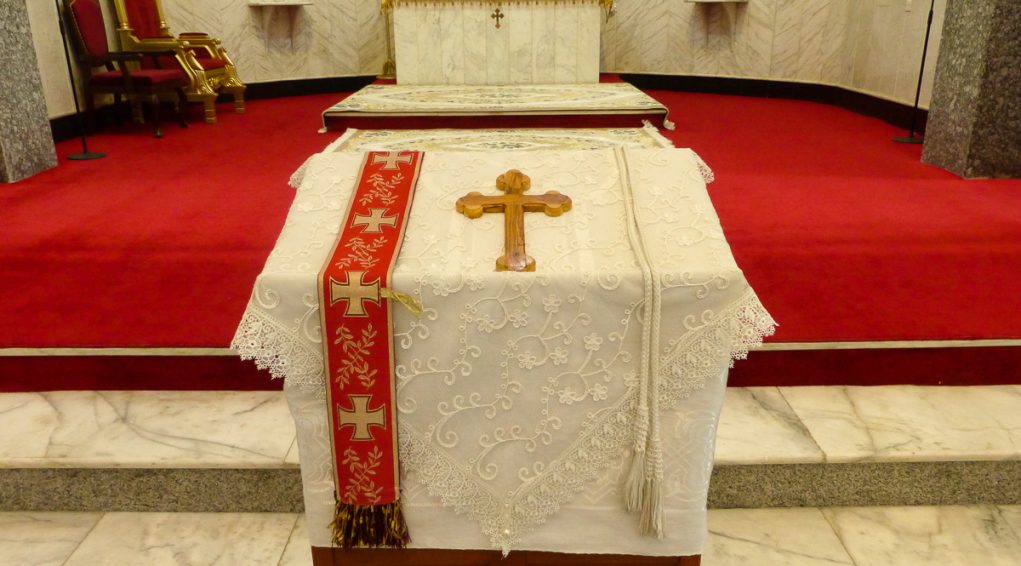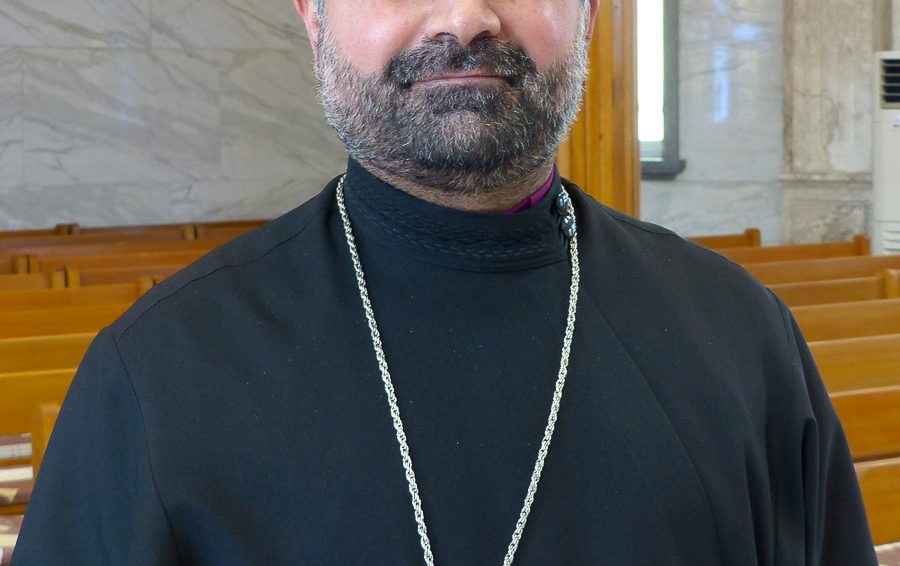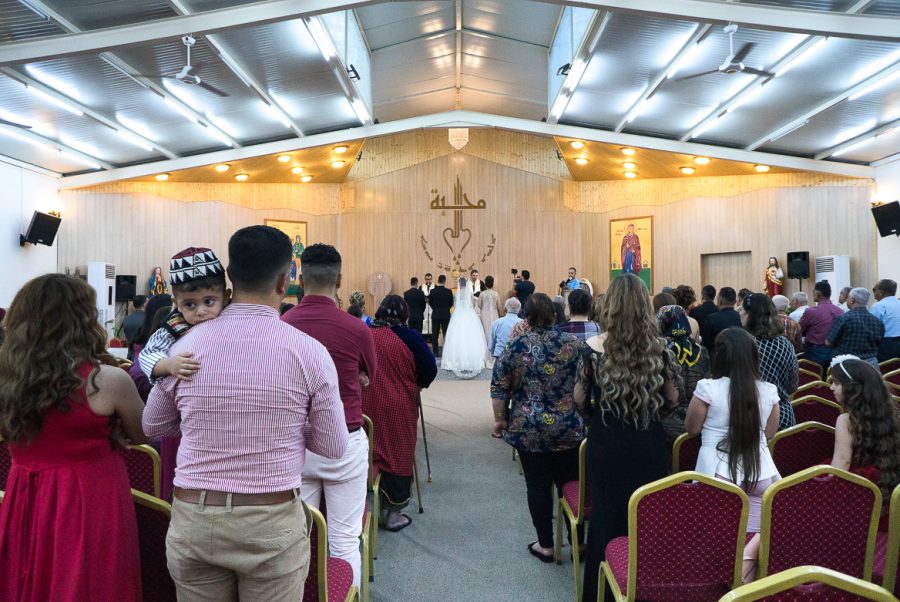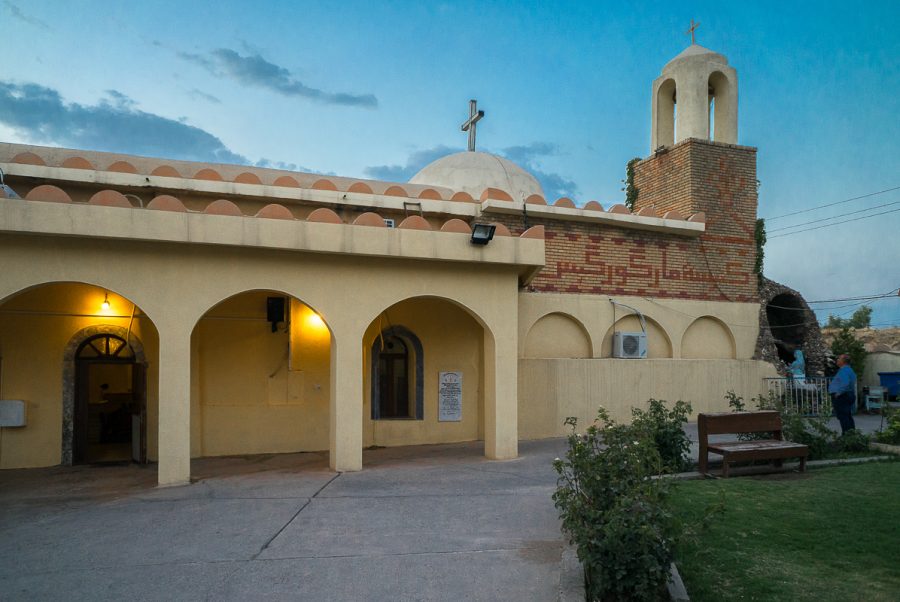Mar Yohanna al Ma’amadan Cathedral in Ankawa
The cathedral of the Assyrian Church of the East, Mar Yohanna al Ma’amadan (Saint John the Baptist) lies at 36°13’55.46″N 43°59’36.61″E and 410 metres high, in the city of Ankawa.
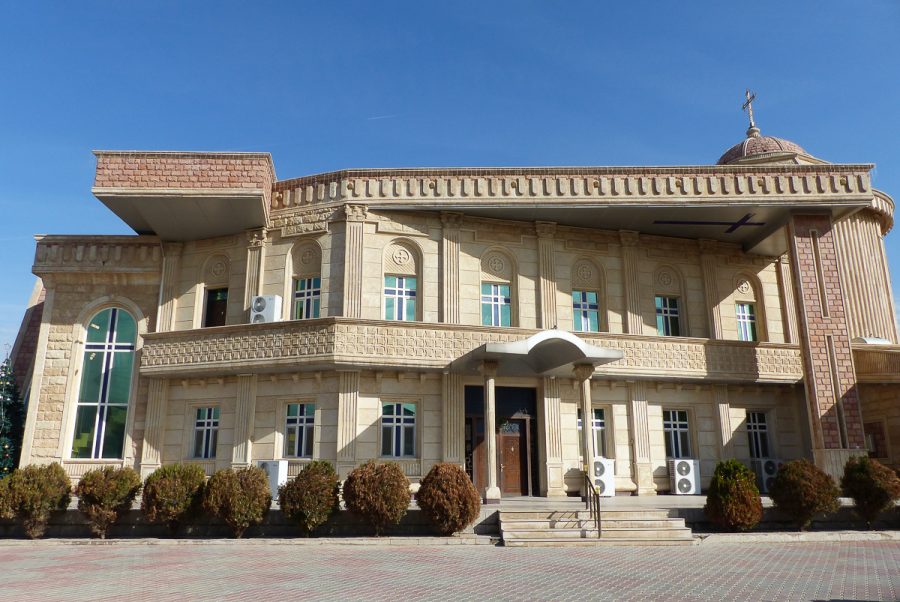
The very recent construction of the cathedral Mar Yohanna al Ma’amadan, Saint John the Baptist church started in 2004.
It was consecrated in October 2008 by His Holiness Mar Dinkha IV, former Catholicos-Patriarch of the Assyrian Church of the East.
The complex- and modern-looking architecture reproduces many symbols of ancient Assyria.
Location
The cathedral of the Assyrian Church of the East, Mar Yohanna al Ma’amadan, Saint John the Baptist church lies at 36°13’55.46″N 43°59’36.61″E and 410 metres high, in the city of Ankawa[1], north of Erbil[2], capital city of the autonomous Kurdistan Region in Iraq.
Ankawa used to be a little village outside the northern gate of the Erbil citadel (Amkabad gate). Ankawa is today fully integrated in the Erbil metropolitan area, and its gravity centre remains the citadel around which the town is organized and grows in circles.
As capital city of the autonomous Kurdistan Region, Erbil counts 1.5 million inhabitants. It lies in the plain, 30 km east from the Great Zab, an affluent of the Tigris River, 80 km east from Mosul and 25 km south from the southern border shaped by the Kurdish mountain.
Saint John the Baptist church, Mar Yohanna al Ma’amadan, sits in the northern part of Ankawa, at the top of the two sides, the main street that crosses the town.
[1]The name Ankawa is used nowadays. In his work Assyrie Chrétienne,vol.I,Jean-Maurice Fiey reports that the city used to be called « ‘Amk Ābād in Persians’ times. From that name, came the name ‘Amkāwa (confirmed in the 14th century), sometimes abbreviated to ‘Amko (already in the 10thcentury). It is only later that the distorted version of ‘Ankāwa appears (18thcentury), then the modern ‘Aïnkāwa..». In the nameAmkabad, the suffix abad, coming from the Persian language, means « the residence of… »
Fragments of a Christian history
Erbil, also referred to as the antique Assyrian city of Arbeles, is quite close from the presumed place of the plain of Gaugamela, where the famous battle took place, offering Alexander the Great a large victory on the Persian Darius III in 331 BC. Former capital city of the Assyrian kingdom of Adiabene, a kingdom that used to be shunted from the Parthian, to the Roman or to the Armenian empires, the area is famous for being in the 1stcentury one of the Jewish community in Mesopotamia that the Christians undoubtedly tried to convert to Christianity. “We have no sources regarding the circles that were concerned with evangelization; however it seems sensible to think that the first ones to convert were taken among Jewish population, very important in those times throughout Mesopotamia, and even beyond the Tigris River, from the days they had been deported to Babylonia by Nebuchadnezzar. Most probable is the fact that the greatest efforts to convert people were focused on these Jewish communities, as it already was the case in all cities of the Roman Empire[1]”. And here again, the first steps of this evangelization’s process were linked to the missions of the apostles Thaddeus, Bartholomew and most of all Thomas and their disciples. The tradition reports that Thomas “made a halt in Selusia-Ctesiphon on his way towards India[2]”.
At the very beginning of the 4thcentury, the area of Abadiene, which was then the most southern territory of the kingdom of Armenia, has gone through a new evangelization’s phase, after Armenia became the very first Christian “state” in History, around 301.
«What also seems reliable is that there has been a meeting, around 328-329, between the only two Christian sovereigns in those times: the Roman emperor, Constantine the Great, and Tiridates III of Armenia. Constantine the Great confirmed Tiridates’ role in evangelizing the East. That is the reason why Armenian missionaries took part in evangelizing Mesopotamia and the Sasanid Empire, as related by the Greek historian Sozomen around 402: “Then, among the border people, the faith grew and worshippers increased in number and I do think that the Persians turned to Christianity thanks to the important relationships they had with the Osroenians and the Armenians[3](…)”». The Christian city of Erbil was made episcopal see, and met with Islam with the Muslim conquest and the Abasid caliphate from the end of the 7thcentury on, thus paving the way to the whole area’s islamisation, which never ceased until today, whoever were the conquerers: Seljuqs, Mongols, Persians, Atabegs, Ottomans or Kurds.
At the very beginning, the Christians from Erbil and Ankawa were members of the Apostle Assyrian Church of the East but they progressively turned to the Chaldean Catholic Church, and this mainly ran through the 18thcentury. And just like the people, the buildings and architectural heritage was transferred from one Church to the other.
In the last quarter of the 19thcentury, the French Dominican missionary Jacques Rhétoré while passing through Erbil wrote that “apart from a few Jewish families, the whole population is Muslim and can number 12 to 15 000 people. (…) Not a single Christian lives in Ervil, whereas there used to be a lot of them in this city, which used to be a place of residence of a Catholic bishop. The Christian population has been persecuted and humiliated in this town for ages, and henceforth left it to settle not far from here, in a place which is today the Chaldean village of Ainkawa (…). Six priests lead today this community of around 250 families”.[4]
[1]In Histoire de l’Église de l’Orient, Raymond le Coz, published by Éditions du Cerf, 1995, p.22
[3]In Arménie, un atlas historique,p.22 and map p.23. Publisher Sources d’Arménie, 2017.
[4]In Voyage d’un missionnaire dans les provinces de Kerkouk et de Solimanié de l’empire turc ,Dominican year, 1879. P. 492-493.
The modern days
At the beginning of the 21st century and as if rewriting History, Erbil has regained its influence as a major Christian centre. The city of Ankawa, north of the city, has indeed welcomed tens of thousands of Christians from Baghdad, Mosul, from the Nineveh plain or from Basra, all fleeing anti-Christians persecutions from Islamic and/or mafia groups that thrived since the United States invaded Iraq in 2003. The refugee policy to welcome Iraqi Christians in the Kurdish part of northern Iraq, implemented by the president of the autonomousKurdish regions in northern Iraq, Massoud Barzani, is clearly perceptible in Erbil-Ankawa. Besides refugee camps for Christians and Yazidis, new and large churches for all denominations have been constructed, including Saint John the Baptist church, Mar Yohanna al Ma’amadan church, cathedral for the Assyrian Church of the East and thousands of Christian families have settled for good in the town. Many schools and medical centres, all run by various Churches, have been built and the Babel College has even been transferred from Baghdad… These varied and multiple initiatives strengthen the Christian vitality of Ankawa. Many Christian NGOs working in the fields of international solidarity and also different Churches in throughout the world also take advantage of this policy as they develop fraternal links with their counterparts in Erbil-Ankawa.
The story of the construction
The very recent construction of the cathedral Mar Yohanna al Ma’amadan, Saint John the Baptist church started in 2004. It was consecrated in October 2008 by His Holiness Mar Dinkha IV, former Catholicos-Patriarch of the Assyrian Church of the East, who died on March 26th2015.
With respect to Christian traditions, the building is eastwards-oriented.
The church is made of cinder blocks and concrete under stone facing, engraved with Assyrian crosses and patterns. On the top of the dome, which rises just above the high altar, stands a shiny bronze trefoiled cross.
The complex- and modern-looking architecture reproduces many symbols of ancient Assyria.
Lengthways, the building is supposed to copy the Assyrian tree of life, above which the god Ashur used to have pride of place in old days.
East of the church, on each side of the choir are located the liturgical chambers, copying the pattern of Ashur’s wings, embracing and protecting the world, and which nowadays are the symbols for the wings bearing God’s spirit.
Parishioners use the door on the southern side of the building to access the church. Both men and women without distinction use that same door to get in the church. At the beginning, Assyrian churches used to have 2 side doors. The men’s entrance, upfront, allowed them to sit as close as possible to the choir, whereas the door at the rear assigned women with the back benches.
The inside of the building is very refined in its ornament, without any fresco or icons. This tradition is supposed to have been inherited from Judaism, in which all representative forms were not allowed in temples.
Just like in all churches in the East, the many crosses in the Mar Yokhanna al Ma’amadan church embody resurrection and life, because Christ has conquered death. This is why there are mainly glorious crosses, trefoiled crosses. As in other Eastern churches, (Coptic, Armenian, Ethiopian Churches…), the Assyrian Church of the East does not allow any representation of the Christ Crucified.
An imposing arch with 3 doors separated the nave where worshipers sit from the Holy of Holies where the altar stands. In the middle of this arch, a beautiful tympanum tops the monumental royal door. It features the beauty of Heaven on earth. The engraved bas-reliefs represent the bread and the cup of wine. They are abundantly decorated with vegetal and floral patterns, surrounding a glorious cross, with the Holy Spirit in form of a dove on top of it. This marble sculpture is adorned with glaring gildings and lattice work, allowing it to glow as if responding, in the liturgy just as in the Eastern spirituality, to Jesus Christ, Light of the World.
A dedicatory prayer is also written in Syriac language and reads “the church with holy voices glorifies the Lord of all creation”.
On either side of the royal door, two tall and narrow side doors open onto two alcoves. The right one is the place where little children are being christened. The left one hosts the sacristy, the beth gazain Syriac language (meaning treasure) and is mainly used for liturgical vestments of the priests, servants and subdeacons.
Everything refers to symbols in liturgical architecture. Therefore, when the royal doors’ curtains are opened, the lights must have been turned on, because the light of the Christ comes and enlightens the worshipers.
The high altar stands against the far wall at the end of the choir, according to the original tradition, so that the celebrant and worshipers can pray all together facing the Lord.
In the middle of the church, a lectern with a wooden cross on top of it, stands as a symbol of the former pulpit, the bima[1]in Syriac language, symbol of Jerusalem, and where the celebrant in old days used to deliver his homily. In modern churches, the pulpit is replaced by a lectern with a cross on top of it and placed in the centre of the congregation.
Monument's gallery
Monuments
Nearby
Help us preserve the monuments' memory
Family pictures, videos, records, share your documents to make the site live!
I contribute
